
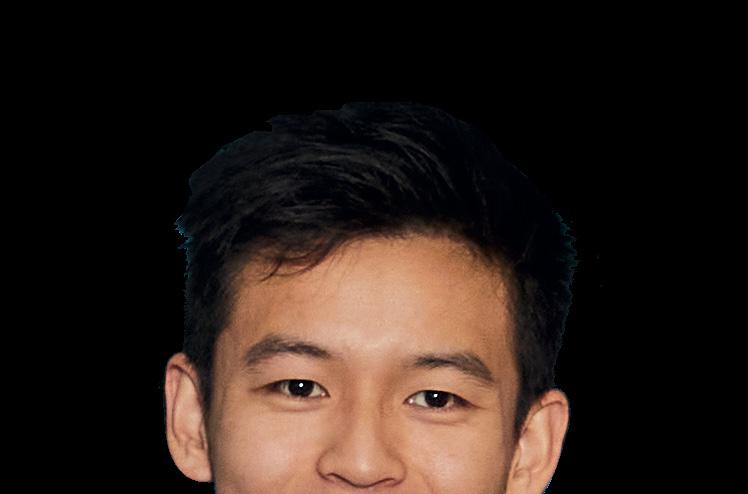
TERM 1, 2023
CAREERS with STEM.COM STUDY PATHWAYS + NUCLEAR SCIENCE + ROBOTS, AI & DATA + MEDICINE + ANCIENT WORLDS Meet STEM experts with cool careers in nuclear science p12 Discover non-uni pathways into STEM p10 Get career inspo – from your year-oldfiveself p6
with STEM™
CAREERS science
WOULD
LIKE A CAREER THAT’S MORE THAN JUST A JOB?
With the world’s population now reaching 8 billion people, the environment, our health and food supply face complex challenges.
The answers to those challenges will be found by curious minds. Studying science at Macquarie will give you new ways of thinking about how individuals, societies and governments can best navigate a path towards environmental, social and economic sustainability.
As well as discipline knowledge, our flexible science degrees – which include the Bachelor of Environment, Bachelor of Biodiversity and Conservation, Bachelor of Science and Bachelor of Medical Science – incorporate career-building skills and practical experience. And by combining a science major with a minor in almost any other subject, you’ll develop unique insights that will help you stand out from the crowd. LEARN MORE
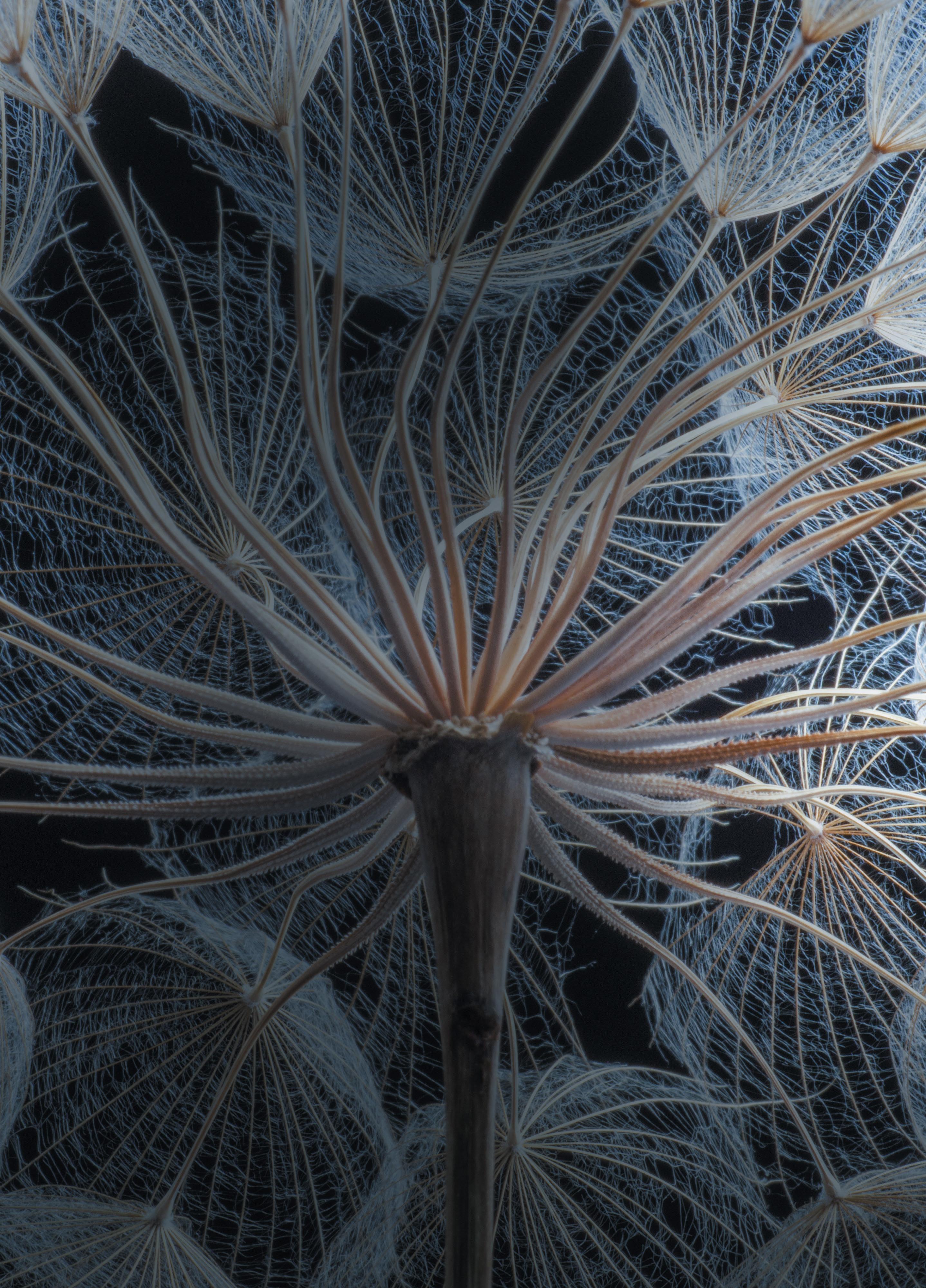
CRICOS Provider 00002J | FSE31747
mq.edu.au/study/find-a-course/science/_
Celebrating science
Science is the foundation of our society, and in the future it will help us to live happier, healthier and more sustainably. How we do that is up to you!
It’s a big year for us at ANSTO – we have turned 70! This anniversary is a good opportunity for us to think about what has been achieved over the past decades – not just in nuclear science and technology, but in science more broadly.
Seventy years ago, at the beginning of the nuclear age, the world was a very different place. Since that time the peaceful uses of nuclear have led to improvements in medicine, brought an understanding of the changes to our planet and revolutionised industry.
Importantly, science has brought a new understanding of our world and the universe.
But while we “stand on the shoulders of giants” in all our scientific endeavours (as the famous English scientist Sir Isaac Newton put it), this magazine isn’t about looking back, it’s about the future – and that means you.
Science is about asking questions, experimenting and figuring out how things work, even down to the most fundamental level of the atom.
While there has been great progress, there are still many questions for the next generation of scientists to answer.
Happy birthday,70thANSTO!
ANSTO (the Australian Nuclear Science and Technology Organisation) is one of the biggest public research institutions in Australia, and a world-leader in nuclear science and technology.
For 70 years, scientists have used ANSTO’s cutting-edge research reactor and facilities in Sydney and Melbourne to solve problems ranging from food science, to climate change, health and energy.
Head to page 12 to read more about the diverse applications of nuclear science, and to meet real scientists with fascinating careers at ANSTO.
My career started out with a degree in biotechnology, followed by sales and leadership roles in the pharmaceutical and medical equipment and devices industries in the UK and the US. Now, I am the chief executive officer (CEO) at ANSTO. It is my job to guide the vision and direction of ANSTO into the future. I wouldn’t be doing anything else.
That’s up to you.
What will your science career look like?

In the pages of this magazine, you’ll meet scientists working in diverse areas – from archaeologists investigating ancient artefacts to virtual reality specialists bringing remote landscapes to life, conservationists-turned- tech specialists helping to save endangered species, and bioscientists improving the diagnosis and treatment of disease.
And, of course, you’ll get to know some of the interesting people working with me at ANSTO, applying nuclear science and technology in equally broad and varying fields, such as developing advanced waste encapsulation technologies, improving high-end silicon and using nuclear techniques to improve our world.
I hope as you read the following pages that you’ll be inspired to think about how you could turn your passions into a meaningful and rewarding science career.
Shaun Jenkinson CEO, ANSTO
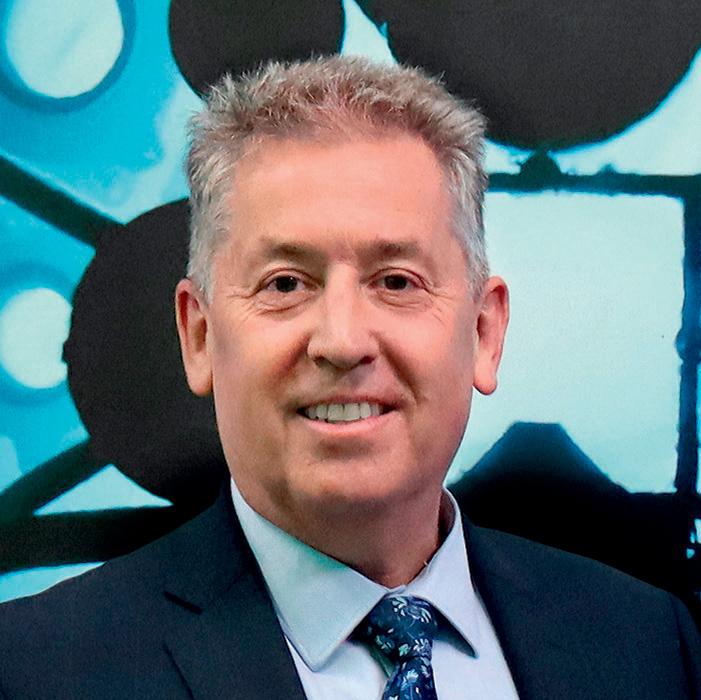
there are still many questions for the next generation of scientists to answer”
shaun jenkinson ceo, ansto Biotechnology, London South Bank University
Sales Manager, Abbott Laboratories
ManagingDirector,Invacare
Director,AustralianSynchrotron
GroupExecutive,ANSTOHealth
CEO, ANSTO
3 SCIENCE FOREWORD
What’s inside?
P5 Kinder careers
Remember what five-year-old you was obsessed with? Use it to inspire your future dream job!


P6 Put your science subjects to work
Match your school science subjects to real-life study and career paths.
P10 Get into VET
Uni not for you? Discover vocational pathways into STEM.

P12 Find your dream job in nuclear science
Wondering what a career in nuclear science could look like? Meet real life nuclear scientists, and discover the diverse applications and career opportunities in this important field.

P28 Next steps
Inspired? Flick to this page to discover what you can do right now to kickstart your career in science.


Why Science?
Science is all about exploring the world and asking questions. And a career in science means you can make a real difference. You can discover new things, develop new technologies and solve problems – from combatting climate change to curing cancer. Whatever your passion or interest, you might be surprised at the career pathways and opportunities in science available to you.
Podcast
Meet a passionate wildlife conservationist turned tech entrepreneur in the latest episode of The Buzz About STEM podcast. CareerswithSTEM.com/podcast

STEM + X =
Combine science (STEM) with your passion (+ X) to discover your dream career. Here are some ideas to get you started…
Science + …

P16 Robots, data & AI
Cutting-edge tech like artificial intelligence (AI) is changing the way we do science. Discover careers that will put you at the intersection of tech and science.
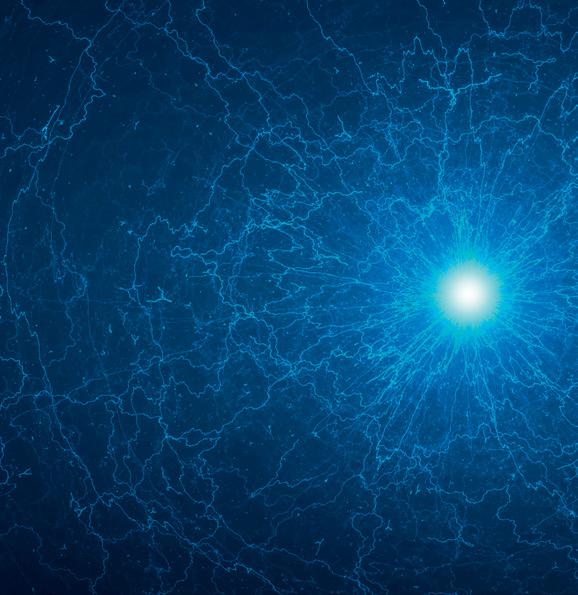

P20 Medicine
Want to save lives with science? You could be a doctor – or you could consider one of these exciting, diverse science + medicine pathways.
P24 Ancient worlds
From understanding ancient climates and civilisations, to reversing extinction, scientists are using future-focused skills to delve into our past.
Video
Watch five impressive women in STEM share their stories about smashing the glass ceiling in our live video from a special QUT event held during National Science Week 2022. CareerswithSTEM.com/videos
Quiz
Interested in a career in cyber security but not sure which path is for you? Take our cyber careers quiz (and more) over at CareerswithSTEM.com/quiz
Double issue! Flip over for environment+data careers
SHUTTERSTOCK
P06 P10 P24 P12 P16
The Buzz About STEM What’s online ... CAREERS with STEM .com 4 CONTENTS
5 SCIENCE Figuring out a career can be exciting. Text ‘SLIS2022’ to 0429 009 435 Call 1800 CAREER (1800 227 337) Are you 15 to 24 years old? You can talk to a real person to discuss your career options. The National Careers Institute empowers Australians to achieve productive, rewarding and fulfilling careers and lifelong learning. yourcareer.gov.au can help you make informed decisions about your learning, training and career development. yourcareer.gov.au YOUR CAREER. YOUR WAY. Book in for a free 45-minute career guidance session with an experienced career practitioner. yourcareer.gov.au/schoolleaver
When I grow up… UPFRONT
Dinosaurs! Space! Sport! Superheroes! Do you remember what you were obsessed with when you were five years old? For some of us, turning our OG passions into real-life jobs might seem far-fetched, but chances are you can create a cool and compatible science pathway by listening to your inner kindergartner. Here, we match childhood obsessions to grown-up study paths and careers. – Cassie Steel
The X factor: STEM+Space
The job: Astrophysicist
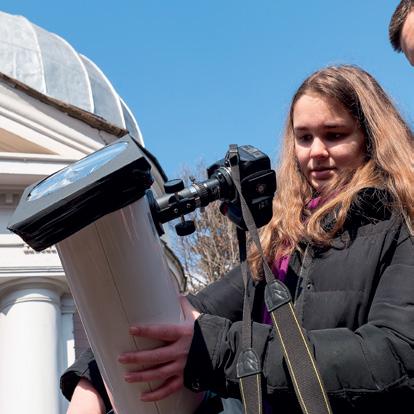
The study path: Bachelor of Science (Physics)
How much you could earn: $77K–$139K*
The chances of scoring a gig at NASA and jetting off to the Moon might seem outta-this-world. But the chances of securing yourself a next-gen space job are sky high – with the Australian Space Agency committed to tripling the size of our space sector in the next decade! Having a science career that involves studying the stars means nailing physics. Stick with it at high school, and you can then major in it at uni before doing a master’s degree or PhD to hone your skill set even more.
STEMRemember: + X [where X is your childhood passion] = your dream career
Visitplus-XCareerswithSTEM.com/STEMfor more ways to combine STEM with your passion – either from when you were little, or now – and find your ultimate study and career path.
The X factor: STEM+Ancient Worlds
The job: Palaeontologist

The study path: Bachelor of Science (Palaeontology)
How much you could earn: $81K–$143K*
Dinosaurs might be a thing of the past – but studying ancient creatures for a living is very much a presentday possibility. Get clued up in conservation and environmental science, and you could score a job in a lab or museum, at a university or in a science media agency.
The X factor: STEM+Crime+Justice
The job: Forensic scientist
The study path: Bachelor of Forensic Science
How much you could earn: $71K–122K*
Equal parts in the lab and in the field, forensic science involves collecting and analysing data to work out the who, what and how of crimes or accidents. You might never have special powers, but you can still carve out a pretty cool science + crime and justice role.

The X factor: STEM+Animals or STEM+Environment
The job: Marine biologist
The study path: Bachelor of Science (Marine Science)
How much you could earn: $76K–$131K*
Did you dream of getting paid to hang out with dolphins?

Welcome to the club!
Becoming a marine biologist requires biology smarts, confidence with maths and data and slick research skills. Look into science degrees with marine science or animal biology majors.
“... I wanna dig up dinosaurs!”
“... I wanna go to space!”
“... I wanna be a superhero!”
“... I wanna swim with dolphins!”
*SALARIES ACCORDING TO SALARYEXPERT.COM SHUTTERSTOCK Find your dream job by asking your five-year-old self CAREERS with STEM .com 6
Real-world Science starts here.
Ella Sinclair’s dream career is to use marine science research to give back to communities impacted by climate change. Once she stepped foot on campus, Ella knew QUT was the university to help her pursue her passion in the real world. With hands-on, practical learning in labs from day one, and regular field trips throughout her science degree, QUT has provided the study experience Ella wanted.
Alongside her on-campus studies, Ella participated in a short-term overseas exchange in Costa Rica conducting field research in the Caribbean Sea and spent 30 days on a research vessel mapping the edge of the Great Barrier Reef. These opportunities enabled her to gain the industry connections and in-depth, hands-on experience to set her up for success.

CRICOS No: 00213J
QUT SCIENCE
SCHOOL SCIENCE
Match your science electives to an awesome career in STEM!




WATCH ME
– Louise Meers
Ever sat in class and caught yourself thinking, “Will I even use this information after leaving school?” If you’re studying biology, chemistry, earth and environmental science or physics in Years 11 and 12, then the answer is definitely ‘yes’ if you’re keen on a future STEM career. Here’s a quick look at how these school subjects can lead to some exciting jobs that use science skills and what kind of uni or VET qualification can help get you there.
These are just a few examples – there are hundreds of amazing study and career pathways in science! To find even more careers, scan here and watch our ‘Match your school science subjects to a STEM career’ video.
LABORATORY ANALYST
Diploma of Laboratory Technology
High school science teacher
SOLAR AND BATTERY DESIGN ENGINEER teacher
WATER TREATMENT PLANT OPERATOR
Bachelor of Science / Master of Teaching (Secondary)
FORENSIC SCIENTIST BIOLOGY
Bachelor of Science (Forensic Science)
Diploma of Conservation and Ecosystem Management
Bachelor of Science, majoring in marine science or marine biology
MARINE BIOLOGIST
PHARMACY TECHNICIAN
Certificate IV in Community Pharmacy
CHEMISTRY
Bachelor of Engineering (Honours) (Chemical)
Bachelor of Science or Forensics, majoring in toxicology
TOXICOLOGIST
DATA ANALYST
Bachelor of Data Analytics
Bachelor of Engineering (Honours) (Renewable Energy)
PHYSICS
Bachelor of Engineering (Honours) (Materials Science)
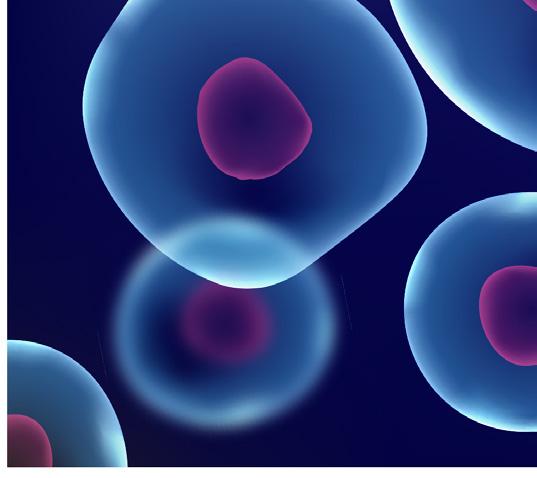
Bachelor of Science (Space Science and Astrophysics)
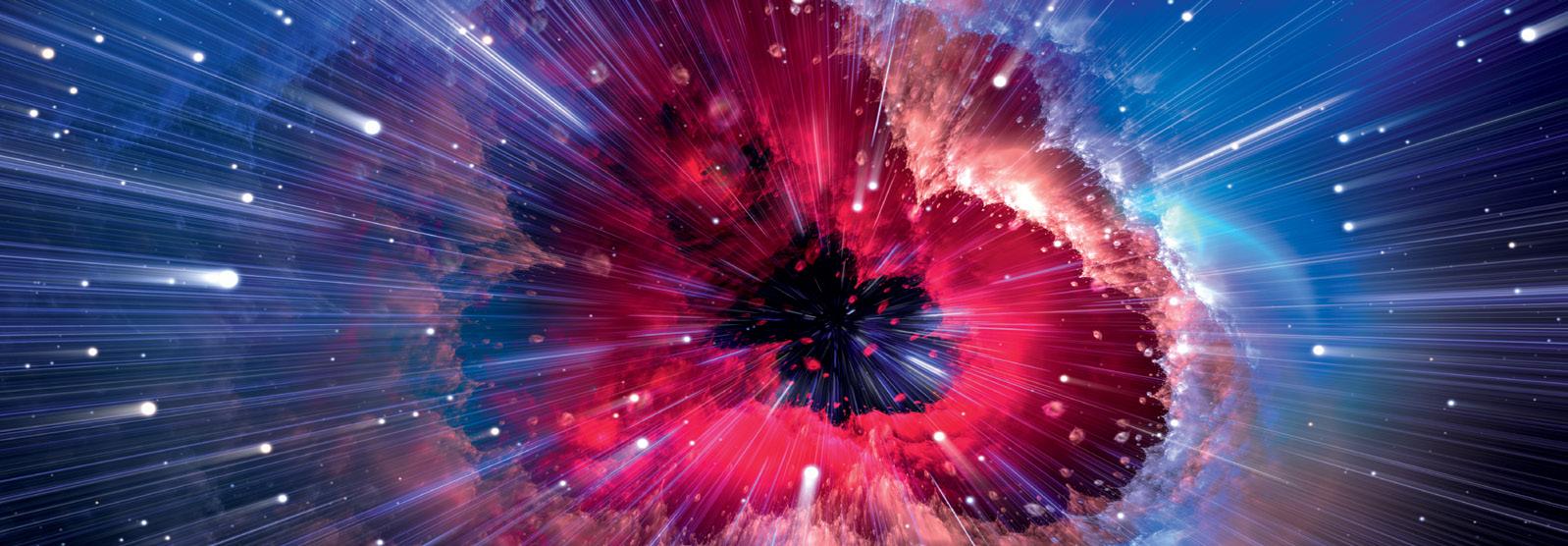
PLANETARIUM DIRECTOR
CLIMATE IMPACT CONSULTANT
Diploma of Sustainable Practice
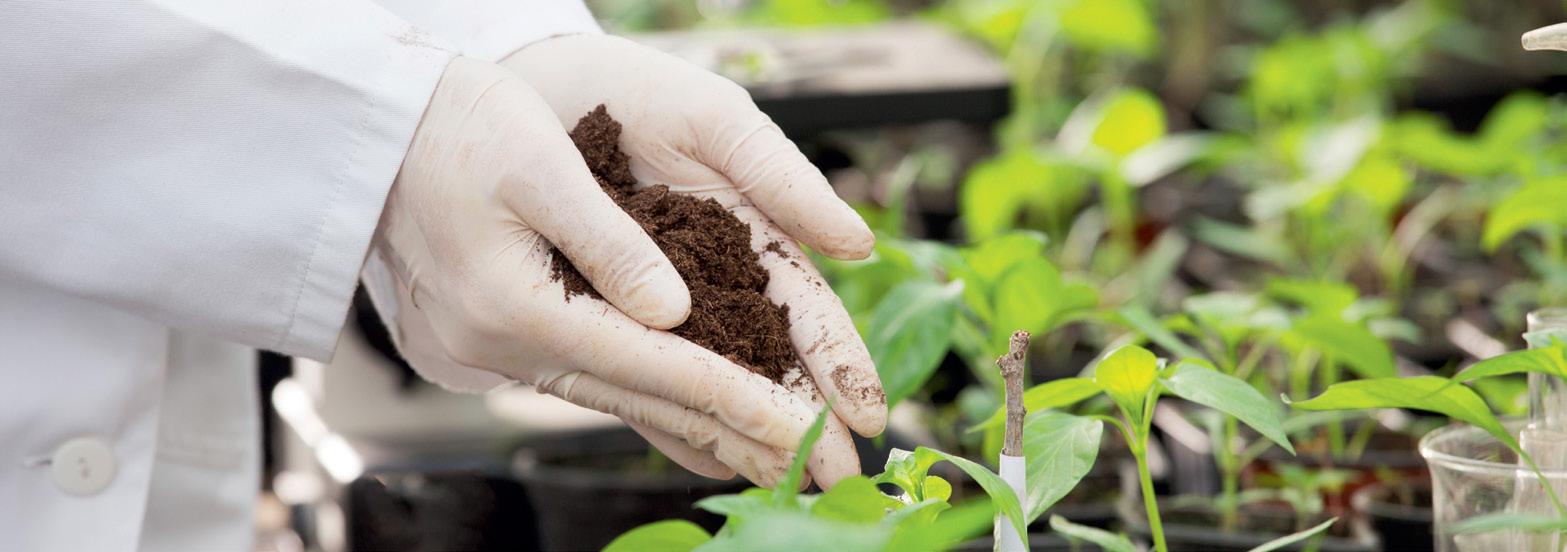
Certificate III in Water Industry Operations (Networks)
EARTH AND ENVIRONMENTAL SCIENCE
Bachelor of Science (Geology)
PALAEONTOLOGIST
Bachelor of Science, majoring in physics, mathematics or climate
THREATENED SPECIES MANAGER
CHEMICAL ENGINEER
MATERIALS SCIENTIST
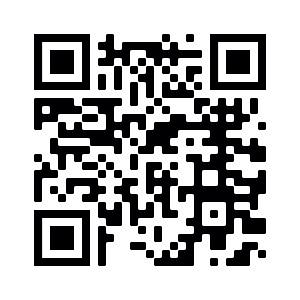

Meteorologist

SHUTTERSTOCK UPFRONT
CAREERS with STEM .com 8
Prepare for the future with STEM studies
At ECU, we offer exciting courses that prepare students for the future by building their skills and knowledge in science, technology, engineering or mathematics.
As the world of work changes through automation, globalisation and the explosion in digital technologies, we need to change our skills to match. That’s why STEM matters. And it matters a lot to us at ECU
At ECU you will learn in some of the best facilities in the Southern hemisphere. That includes industry-standard engineering facilities and a purpose-built Science building packed with state-of-the-art laboratories and the latest technology.

Explore STEM at ECU
Courses are delivered across five of our teaching schools, including Medical & Health Sciences, Nursing & Midwifery, Engineering, Science and Education. Visit our STEM web page to find out more: www.ecuworldready.com.au/stem
9 SCIENCE
CRICOS Provider No. 00279B CS22010232 NOV22 TM
BE JOB READY
FIND YOUR DREAM STEM CAREER WITH ONE OF THESE AWESOME VET PATHWAYS
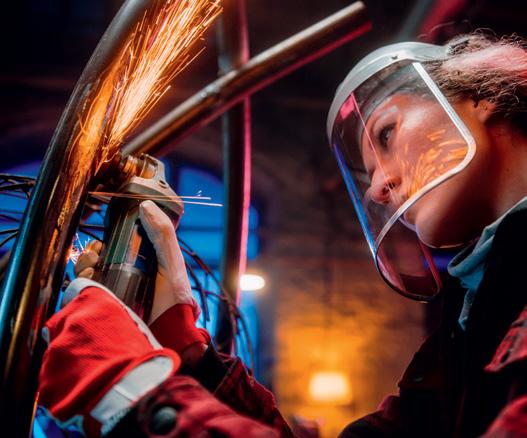
From lab technicians to web developers, vocational education and training (VET) is crucial in equipping people with the skills they need to make their mark in STEM careers. VET courses typically take place at TAFE institutions and colleges and can be a great choice for anyone who wants to gain skills and qualifications without the fees and time commitment that uni degrees often come with. Below, we’ve listed some excellent VET qualifications that’ll set you up for a career in STEM. – Louise Meers
SCIENCE
• Diploma of Laboratory Technology >> lab technician
• Diploma of Dental Technology >> dental technician
Did you know?
VET courses can also be a stepping stone to a degree or can add to your uni qualifications, giving you practical skills for your career. For example, a Diploma of Nursing could help you get into a Bachelor of Nursing at uni, allowing you to become a registered nurse.

• Diploma of Nursing >> enrolled nurse
• Diploma of Conservation and Ecosystem Management >> sustainability manager
• Diploma of Agriculture >> agronomist
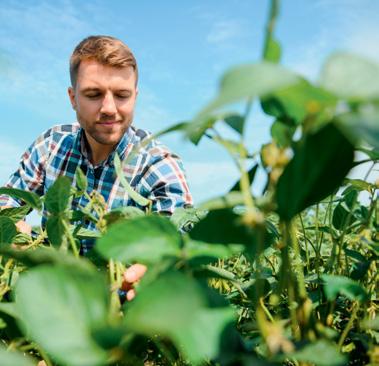
TECHNOLOGY
• Certificate III in Telecommunications Technology >> telecommunications tradesperson
• Certificate IV in Cyber Security >> website penetration tester
• Certificate IV in Information Technology (Gaming Development) >> game developer
• Certificate IV in Information Technology (Networking) >> network support technician
• Certificate IV in Information Technology (Programming) >> junior developer
• Diploma of Information Technology >> web developer
CASE STUDY
• Diploma of Information Technology (Database and Data Management) >> systems administrator
• Diploma of Information Technology (Game Art and Design) >> animator

Passionate about science and animals, it was a Certificate III in Captive Animals that landed Corey Tutt OAM his first job at Shoalhaven Zoo. He later qualified as an animal technician at TAFE and worked as a research assistant at the University of Sydney. Corey, a Kamilaroi man, has since founded Deadly Science, an awesome initiative to equip remote Indigenous schools with STEM resources. Living proof you can kick some serious STEM career goals with a VET pathway!
ENGINEERING
• Certificate II in Engineering >> production worker
• Certificate III in Engineering – Fabrication Trade >> blacksmith
• Certificate III in Engineering – Mechanical Trade >> fitter
• Certificate III in Engineering – Technical >> mechanical engineering technician
• Certificate III in Process Manufacturing >> mineral products manufacturing officer
• Certificate IV in Plumbing and Services (Hydraulic Services Design) >> hydraulic designer
• Diploma of Engineering – Technical (Mechatronics) >> robotics engineer
• Advanced Diploma of Engineering (Mechanical) >> design engineer
MATHS
Maths is the language of STEM and is super important if you’re studying science, tech or engineering. If maths wasn’t one of your electives at school and you find yourself needing to scrub up on it before diving into a VET qualification, TAFE has got your back. You can sign up for bridging programs to sharpen your numbers game so you’re fully equipped for a future STEM study and career path.

SHUTTERSTOCK
VET PATHWAYS CAREERS with STEM .com 10
A headstart to success
The experience of building his own computer in school got James hooked on IT. “I loved the research and learning involved, and the satisfaction at the end when it finally turns on is unforgettable,” he says. “One of the great things about IT is that all you need to start learning is a computer.”
An interest in computers and electronics led James to take a vocational education and training (VET) course and school-based apprenticeship, working in his school’s IT department. It not only counted towards his final grades, it also helped in other ways.
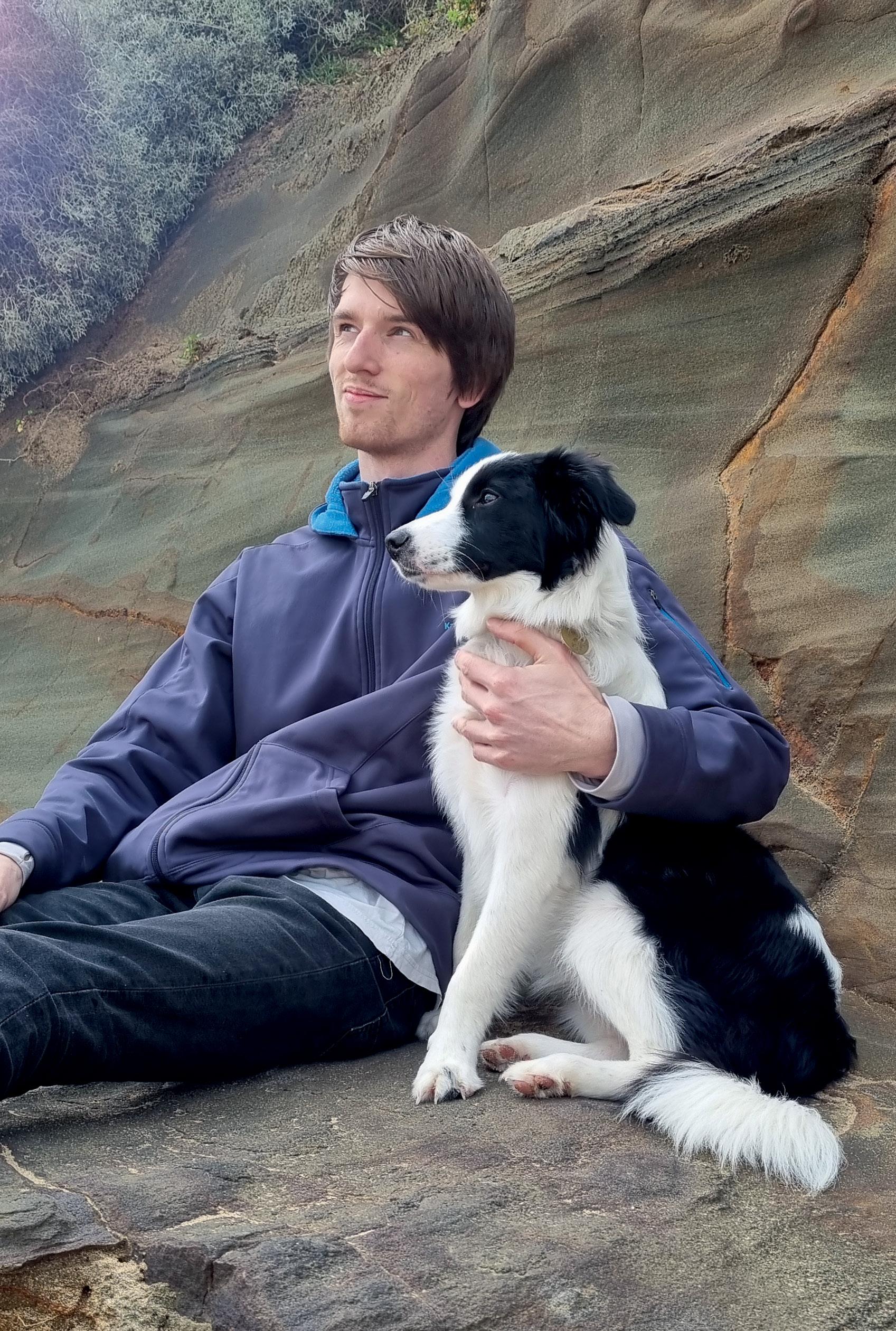
“I feel that my apprenticeship gave me a headstart on the coursework – lots of my first year studies were things I had already learnt through my certificate III or experienced through work in the IT department.”
But the second, perhaps even greater, advantage came later when scholarship, internship and work
opportunities became available. “I was amazed by how relevant my school-based apprenticeship was. Having experience really helped my applications stand out and was an important talking point in job interviews.”
Programming a career
Now a software engineer, James says he loves being hands-on and writing code every day. Along with trying online programming tutorials, his advice to students is to look for opportunities such as conventions, trade shows and camps.
“Before starting Year 12, I spent a few weeks at the National Computer Science School programming bootcamp. Being immersed in an environment filled with passionate students and experts will teach you more in a short period than you thought possible.”
The best thing about working in IT? “It never gets stale. It’s always evolving quickly and I’m constantly learning new things.” – Danielle Lucas
jamessoftwareschifferle engineer
Certificate III in Information, Digital Media and Technology, Swan Hill College Graduate Programmer, Box Hill Institute (TAFE) Bachelor of Computer Science, La Trobe University Software Engineer, Banxa Internship, TechnologyOne Software Engineer, Aussie Broadband VET PATHWAYS + NATIONAL CAREERS INSTITUTE
i was amazed by how relevant my apprenticeship was”
11 SCIENCE
An Australian school-based apprenticeship kickstarted James Schifferle’s STEM career
discover Nuclear Science careers
What’s your nuclear science + X? Combine this exciting field with another passion or interest to find your dream job!

Do you love physics and chemistry and want an exciting, future-proof STEM career that can make a real difference? You should consider a career in nuclear science. While this branch of science is all about looking at the world on a very small scale – think: the scale of the atom – its potential applications are huge. Nuclear science can be used to understand and address issues ranging from climate change to cancer. Start with a Bachelor of Science majoring in nuclear science or medicine, and add a nuclear science postgrad qualification later on. Below, we’ve highlighted seven ‘nuclear science + X’ areas to get you thinking. Plus you’ll get to know some real-life role models (or future mentors). – Gemma
Chilton
STEM all-rounder
Raya Tasnim studied both science and engineering at uni – and landed a job that combines all her STEM skills
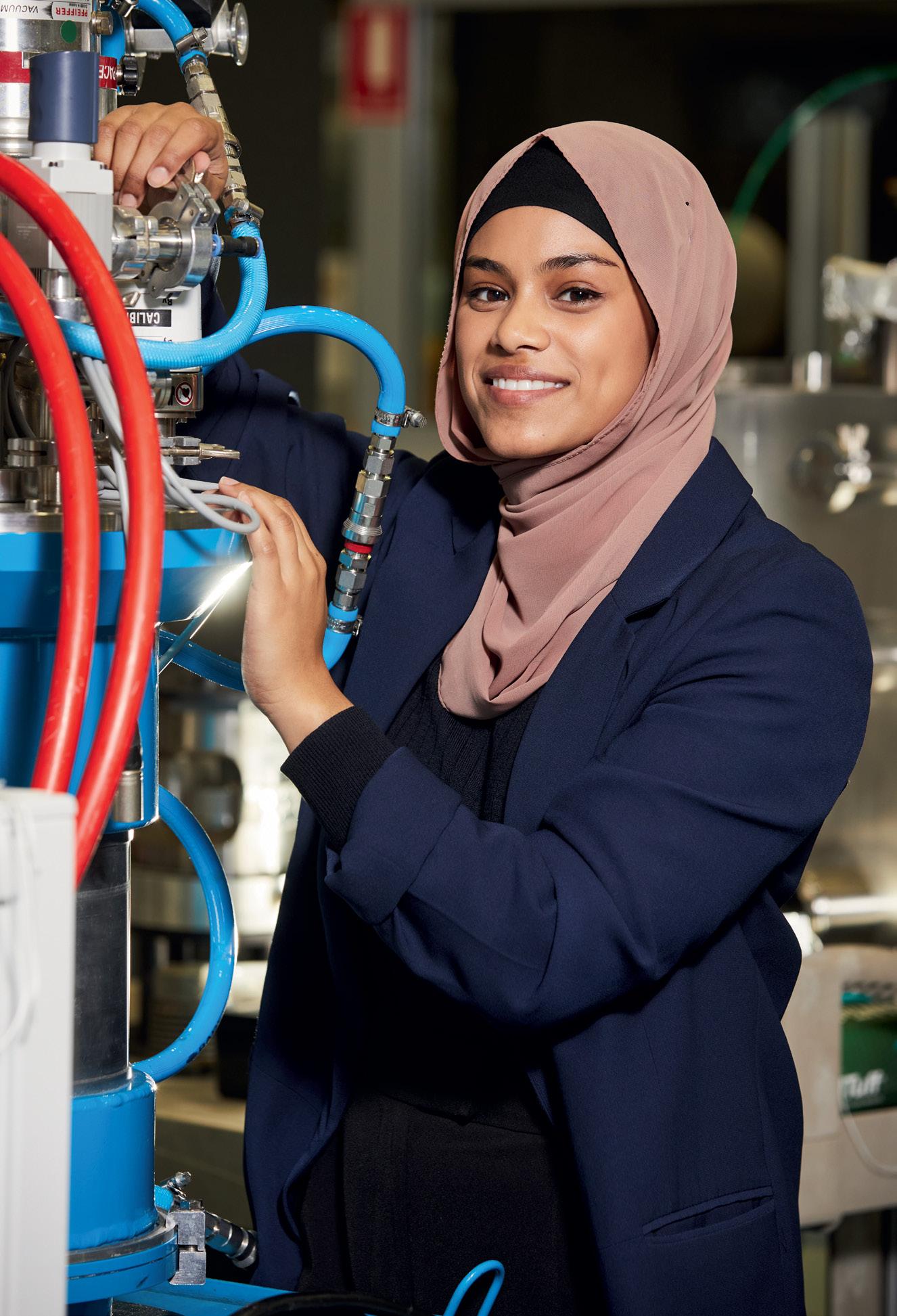
Raya is a silicon irradiations engineer at ANSTO, which means she’s involved in the production of the semiconductors used in high-end electronics, such as satellites and bullet trains.
In her STEM career so far, Raya says ‘imposter syndrome’ has been one of her biggest hurdles. And while she reckons a little bit of imposter syndrome can be ok, too much self-doubt can stop you from stepping out of your comfort zone.
While Raya loves her current role, she has big dreams of getting involved in space exploration. And with all the space research going on at ANSTO, that’s a goal she might not even have to change employers to achieve!
ANSTO is one of Australia’s leading scientific institutions, employing more than 400 scientists and hundreds of others in nuclear industry professions. Researchers from around the world come to use its state-of-the-art nuclear science facilities in Sydney and Melbourne.
Nuclear science +Food&Agriculture
Nuclear scientists use irradiation techniques to combat pests and disease. Nuclear techniques are very useful in studies to increase crop and livestock production and monitor water resources. ANSTO scientists are also working at the forefront of food science, for example developing food products that are lower in fat and higher in resistant starch, which is good for gut health.
Nuclear science +Environment
Nuclear science has many applications in environmental studies. ANSTO facilities are used to study ancient climate variability, pinpoint sources of pollution, understand the impact of human activities on aquatic ecosystems and contribute to sustainable water use.
Raya’s top career tip
Don’t stress about having it all figured out right away – some people specialise and stick to one field for their entire lives, others try something new every year. You can be successful and make an impact both ways.
LAUREN TROMPP SHUTTERSTOCK
SCIENCE + ANSTO
Raya Tasnim Silicon Irradiations Engineer
Bachelor of Mechanical and Manufacturing Engineering (Honours) / Bachelor of Materials Science, UNSW Sydney
Intern Mechanical Engineer, Arup
CAREERS with STEM .com 12
Graduate, ANSTO Silicon Irradiations Engineer, ANSTO
Hands-on learner
Joshua works at ANSTO’s new nuclear waste treatment facility known as Synroc, which processes nuclear waste from the production of nuclear medicine.
“I currently work at the Synroc demo plant which serves to prove the feasibility of the technology,” he explains. “I work with other engineers to deploy, maintain and implement the electrical systems.”
Joshua’s favourite project so far has been working on Coris360, a radiation imaging camera, which helps keep workers safe by detecting invisible radiation.

“I was able to further improve my programming skills, as well as get more practical hands-on experience working with analogue electronics. Overall, the project was a good mix of the skills I want to continue developing in the future.”
joshua’s top career tip
Get involved with events and student teams as early as possible. Just putting yourself out there and talking to people can lead to unexpected opportunities.
Nuclear Science+Space
Want to reach for the stars? Researchers at ANSTO study materials from our Solar System and beyond, and test how Earth materials might withstand the high-radiation environments in space. They also investigate the impact of space radiation on human cells to help keep astronauts healthy. ANSTO’s startup accelerator, the nandin Innovation Centre, is home to some cool space tech startups, like Ouranos Systems – an innovative Aussie company designing nuclear-based power systems for space.
Nuclear science +Defence
Want to use your STEM skills to keep our nation secure? Nuclear science can be a great pathway into defence, for example through advanced materials science used in ships and protective clothing for military personnel. ANSTO is supporting the special task force responsible for delivering nuclear-powered submarine capability in Australia. The Department of Defence offers high-performing STEM students scholarships of up to $20K per year to skill up in nuclear science and engineering.
Nuclear science+Energy&resources

World-leading nuclear scientists and engineers at ANSTO are working with industry to find new ways to extract and process critical minerals such as lithium – used in batteries in electric cars and electronics. Nuclear science also has many applications in the mining sector, for example nuclear scanning techniques have been used to detect precious metals and critical minerals in drill cores samples.
NUCLEAR SCIENCE + STUDY
UNDERGRAD
Bachelor of Medical Radiation Science, Charles Sturt University
Bachelor of Radiation Sciences, Monash University
Bachelor of Science (Nuclear Science and Space Radiation Technology), University of Wollongong
POSTGRAD
Master of Science in Nuclear Science, ANU
Master of Engineering Science (Nuclear Engineering),
UNSW Sydney
VET COURSES
Certificate III in Science
NUCLEAR SCIENCE + JOBS
Medical physicist
$115K–$209K
Nuclear engineer
$103K–$184K
Nuclear medicine technologist $59K–$123K
Nuclear reactor physicist
$82K–$145K
Radiation safety officer
$127K (avg)*
*Salary info according to payscale.com and salaryexpert.com
Joshua Yi Electrical Engineer
START YOUR CAREER HERE
Read Joshua and Raya’s full stories – and meet more nuclear science career role models at CareerswithSTEM.com/ANSTO
Joshua Yi likes learning and working with his hands, which makes his job working with ANSTO’s state-of-the-art facilities and tools the perfect fit!
Bachelor of Electrical and Computer Systems Engineering / Bachelor of Science (Applied Mathematics), Monash University
13 SCIENCE
Software Engineer, Monash Connected Autonomous Vehicle team Electrical Engineer, ANSTO
Nuclear science+Ancient Worlds
If you’re interested in working with ancient civilisations or fossils, chances are you’ll need nuclear science. That’s because nuclear science can be used to determine the age of ancient artefacts. ANSTO scientists have dated Aboriginal rock art in the Kimberley and Kakadu, and they’ve helped investigate the history of the armour worn by the infamous Kelly Gang bushrangers.
Pathway inspo
Meet two nuclear scientists with senior roles at ANSTO, and check out how they got there

#2
The job: Working with radiation and radioactive materials is risky business. Andrew’s team oversees radiation safety and protection for all of ANSTO, as well as its customers around the country. This includes radiation monitoring, safety and protection training, emergency response preparedness, and general advice and leadership.
The pathway: Andrew studied physics and worked as a physicist in nuclear safety roles in the UK before joining ANSTO in 2010, working in radiation health and protection roles.
Coolest thing about your job?
“I feel like I have the most important job at ANSTO. It’s a lot of responsibility but I have confidence in our processes.”
Career tip: “Don’t feel pressured to try mainstream employment. There are some amazing opportunities in the nuclear industry that you won’t find anywhere else.”
Radiochemist,ANSTO
Bachelor of Science (Geoscience), UTS
The job: Jennifer leads ANSTO’s Nuclear Stewardship Research infrastructure team, which advises the Australian Government on nuclear science and technology, and ensures Australia’s use of nuclear science and technology is safe, secure and sustainable.
The pathway: Jennifer joined ANSTO as a radiochemist over 20 years ago and has worked on lots of cool projects, including using nuclear science techniques to track pollution in the environment. Now she uses her skills in leadership roles.
Bachelor of Applied Science (Chemistry), UTS
Consultant Health
Physicist, National Nuclear Security, Atomic Weapons Establishment, UK
Senior Health Physicist, ANSTO
Physicist, ANSTO Manager, Radiation Protection Services, ANSTO
Coolest thing about your job?
“ANSTO is the only research facility with extensive capabilities to apply nuclear technologies to improve our world. And I am a part of it”.
Career tip: “It takes time to gain confidence in your scientific abilities. Be patient with yourself.”
Nuclear science+Health
Have you ever had a nuclear medicine scan? Many of the radioactive substances we need for these tests are made right here in Australia. ANSTO’s multi-purpose reactor, OPAL, produces most of the radioactive isotopes used in 700,000 life-saving procedures in Australia every year. So if you want to combine physics with a lifesaving career, nuclear medicine should be on your radar.
Jennifer Harrison Leader,StewardshipNuclear
SCIENCE + ANSTO
Andrew Popp Manager, Radiation Protection Services
#1
Leader, Nuclear Stewardship, ANSTO
Senior Radiochemist, ANSTO
Bachelor of Science (Honours) (Physics with Nuclear Astrophysics), University of Surrey, UK
LAUREN TROMPP CAREERS with STEM .com 14
Biomedical Science can lead you anywhere
Interested in science and want to make a positive impact? A degree in Biomedical Science can lead to a career you never dreamed of.
Biomedical Science is a field where you could make new discoveries about how the human body functions or find cures for diseases. You might solve health or business problems using maths and biology or even apply your skills as a forensic scientist.

Learn in the best labs
At Edith Cowan University (ECU), you’ll find yourself in a lab coat from day one. And you’ll have access to the latest tech in our cutting-edge Superlabs, equipped for microbiology, genetics, histology and biochemistry. You’ll also be taught by industry leading experts who’ll prepare you for a bright future!
Got you interested?
Applications for this course are open for 2024.
If you’d like to find out more, start your investigation at this page: ecuworldready.com.au/biomedical
15
SCIENCE
CRICOS Provider No. 00279B | CS22010073 NOV22 THE GOOD UNIVERSITIES GUIDE 2023 TEACHIN G QUALITY
Get the intel
Data science and artificial intelligence
(AI) have transformed the way scientists conduct their research. What used to take weeks, months or years to analyse can now be done in days or even hours.
AI and data science have applications in every scientific field. For example, the Australian National Herbarium is digitising nearly a million plant specimens and analysing them through machine learning. CSIRO is using AI and data to predict the spread of bushfires. And IVFAustralia is developing a system that can choose the embryo most likely to result in a pregnancy.
Transferable talent
Workers with AI skills are in huge demand. In Australia, just over 20% of startups say AI is relevant to what they do, and by 2030 we will need an extra 161,000 AI specialists. That’s a lot of jobs!
AI skills such as machine learning, computer vision and natural language processing are not only super useful in science careers, they can also be applied to just about any other industry. And given that

people with AI skills make on average $111,000 a year, learning them could really pay off.
Epidemiologist Jenny Vo took advantage of her transferable skills to make a post-pandemic career change.

“As an epidemiologist, I guess my end- game was a pandemic. I just didn’t expect it to come so soon,” she says. “I actually had a bit of a crisis, like, ‘is that it?’.”
Jenny spotted an ad on LinkedIn for a data consultant role at AI consultancy firm Eliiza, where she now works. “I used to think that what I knew about data was only applicable to health, but I learnt that it’s applicable to many other areas. Plus, when you come from a different industry, you can offer another perspective.” – Chloe Walker
Skill up
There’s more than one way to combine your science studies with futurefocused skills in AI and automation.
Double down
Combine a Bachelor of Science with a second degree in IT, computer science or engineering (software, robotics or automation).
Do it later
There are loads of specialist qualifications in AI, data science and machine learning at postgraduate level. Get the science knowledge first as an undergrad, then add the rest later.

DIY
Lots of tech specialists are self-taught, and plenty of employers respect that. Look for courses and tutorials online to get started.
SHUTTERSTOCK
SCIENCE + DATA, AI & ROBOTICS
When you come from a different industry, you can offer another perspective”
Skills in data science, AI and automation can supercharge your science career
Bachelor of Science (Pathology and Laboratory Medicine), University of Western Australia
Master of Infectious Diseases, University of Western Australia
Master of Public Health, University of Western Australia
Epidemiologist, WA Health
Master of Data Science and Artificial Intelligence, University of London
Data consultant, Eliiza
CAREERS with STEM .com 16
jenny vo data epidemiologist
georgina siggins
ai consultant AI and empathy
There’s caring behind the code for Microsoft AI consultant
Georgina Siggins
An urge to help has driven Georgina from an early age – starting with a sick relative during her childhood.
“I remember becoming really interested in how technology could help improve her care and health outcomes. That really inspired me,” she says.
Georgina went on to study a double degree in biomedical science and engineering at the University of Queensland. Then she discovered code.
“I realised that with nothing but a computer you could create something that could solve problems.”
From habitat to human wellbeing
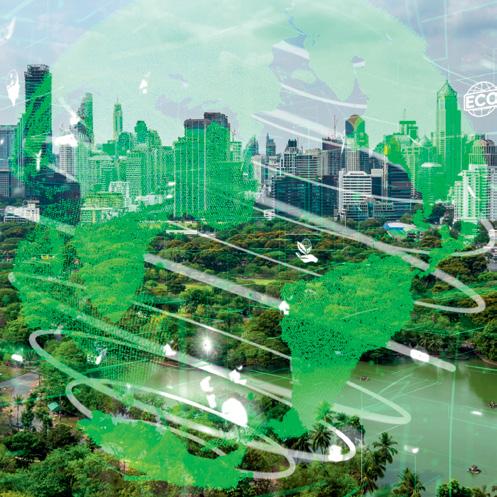
During her studies, an internship at Microsoft turned into a full-time job offer. She now works with Microsoft clients on projects that involve artificial intelligence (AI) and the Internet of Things – from helping the Australian Government monitor habitat diversity in Kakadu National Park, to improving student wellbeing during the pandemic lockdowns.

But the most important thing, she says, is to be of service to the world. “AI and machine learning touch every single industry. It’s an incredible opportunity to have empathy and be caring.” – Chloe Walker
Bachelor of Engineering (Honours) (Electrical and Computer Engineering) / Bachelor of Science (Biomedical Science), University of Queensland Intern, Microsoft Technology and Innovation consultant, self-employed ProgramMicrosoftmanager, Internet of Things service lead, Microsoft
It’s my speciality
Depending on your major, you could find yourself working anywhere from government to academia, a big global company or a tiny startup. The options are (almost) endless! Here are some possibilities to get you started:
Chemistry
Biotechnology and pharmaceutical companies such as CSL, GSK or startup Pending.AI.
Physics
Australia’s Nuclear Science and Technology Organisation, The Australian Defence Force and its contractors, or the Defence Science and Technology Group.
Health and biology
Medical research institutes and hospitals such as the Doherty Institute, the Walter and Eliza
Hall Institute and CSIRO, or health-tech startups such as Harrison.
Environmental and earth sciences
The Bureau of Meteorology, Geoscience Australia, mining companies or environmental departments within government.
Wild card
Don’t forget those transferable skills! You could work at Deloitte or PwC, in a consulting firm such as Eliiza or Intellify, or at a tech company like Microsoft or Amazon.
SCIENCE + DATA, AI & ROBOTICS + STUDY

UNDERGRAD
Bachelor of Engineering (Honours) (Automation and Robotics Engineering) / Bachelor of Science, University of Western Australia
Bachelor of Computer Science (Machine Learning) / Bachelor of Science, University of Queensland
Bachelor of Science / Bachelor of Advanced Computing (Honours) (Artificial Intelligence or Machine Learning ), Australian National University
VET COURSES
Advanced Diploma of Robotics and Mechatronics Engineering
Certificate IV in Integrated Technologies (Robotics Control Systems)
SCIENCE + DATA, AI & ROBOTICS + JOBS
Data scientist $65K–$128K
Data analyst $54K–$102K
Machine learning engineer $59K–$137K*
*Salary info according to payscale.com and salaryexpert.com
START YOUR CAREER HERE 17 SCIENCE
Using data and robots in space science
Using data from a robot on Mars to teach geology through virtual reality in the outback... that’s all in a day’s work for QUT PhD candidate Cael Gallagher!
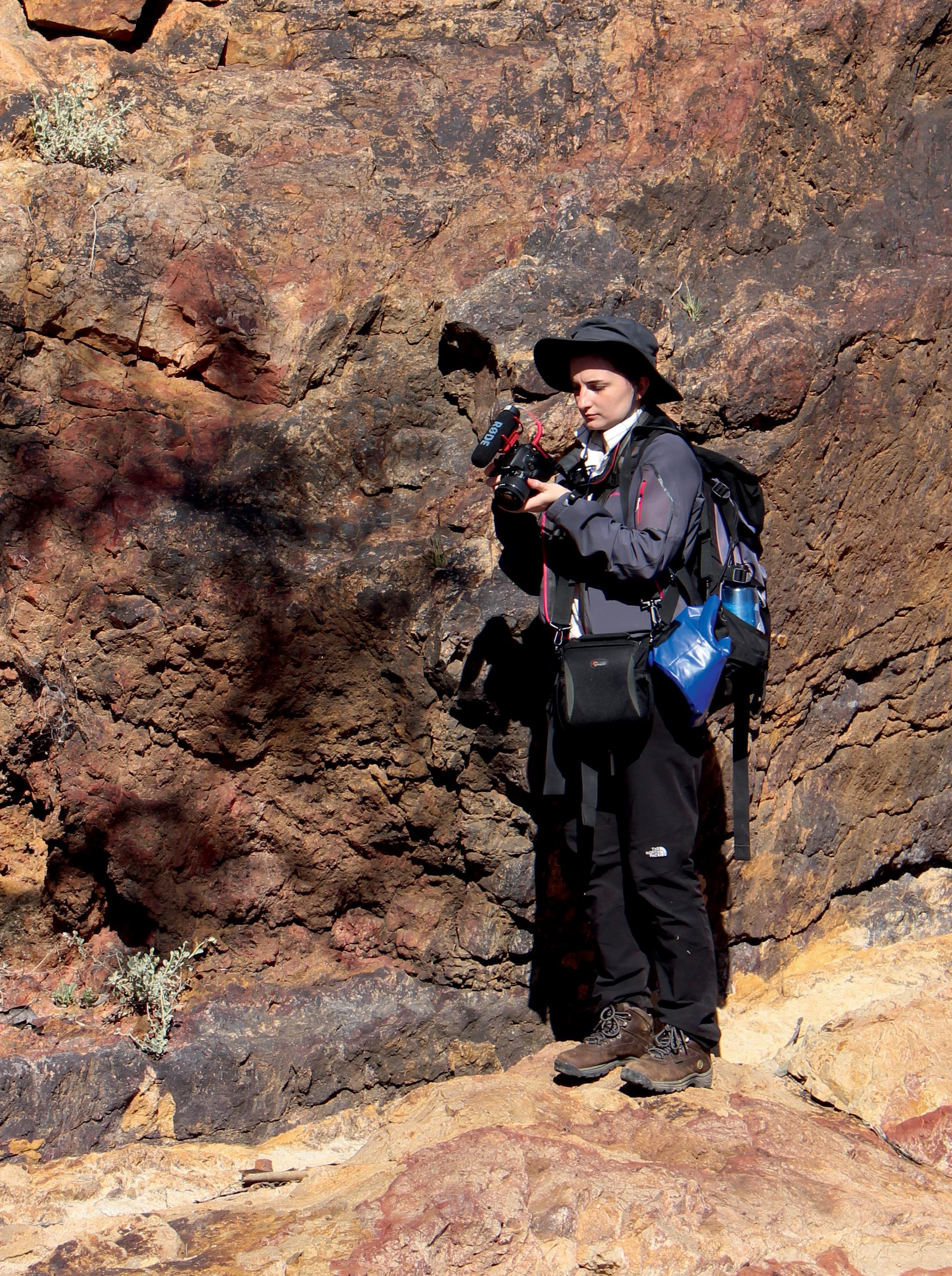
Having studied psychology and technology in the Netherlands, Cael now finds herself immersed in the geology of the Australian outback.
“Every day is different, which is really fun,” the QUT PhD candidate says of her multidisciplinary role working with QUT’s School of Earth and Atmospheric Sciences.
Cael is helping to develop virtual reality (VR) solutions for geology research and education to enable researchers and students to learn and analyse data in environments that they can’t physically get to… like Mars.
Cael’s background in human-computer interaction – the study of how humans interface with the electronic world – inspired her interest in ‘serious games’: interactive tools for learning and training purposes.
Diverse data needs
From photographs and field notes to remote- sensing, data is pivotal to the project. Cael says the challenge is collating it all in a way that makes sense. “Because we are not physically on Mars, we acquire data remotely via the Perseverance Rover and that’s something we do on Earth a lot by using satellites and drone photogrammetry [taking measurements from photos]. Part of the project is making that data feel less remote and more tangible,” she explains.
Travelling to the outback regularly, Cael has discovered she loves fieldwork. “I have these opportunities to go into beautiful places around Australia and I come back invigorated with a whole new approach to tackling problems. I work with a really good team that collaborates to produce amazing results.”
The future looks super exciting for Cael, who loves the idea of being an expert in her field. “It would be cool to go to some of the really remote parts of the world, like Antarctica, and document them for virtual reality,” she says.
“So few people get to go to these unique places, so to do it for science and make it more accessible would be amazing.” – Danielle
Lucas
SCIENCE + DATA, AI & ROBOTICS: QUT
It would be cool to go to really remote parts of the world and document them for virtual reality”
cael gallagher
PHD candidate
Teaching assistant, Eindhoven University of Technology the netherlands
PhD candidate (Immersive Systems for Geology Education), QUT
Master of Philosophy (Human-Computer Interaction), QUT
CAREERS with STEM .com 18
Bachelor of Psychology and Technology, Eindhoven University of Technology, the netherlands
Passion for plants
Bettina Berger’s love of nature sowed the seeds for a successful career in research and science leadership
Watchinggrass grow is a famous way to describe something boring – but there’s nothing boring about the research going on at The Plant Accelerator, especially if you love plants as much as its scientific director, Bettina.

Located at the University of Adelaide, the Plant Accelerator is Australia’s biggest automated research greenhouse. There, scientists literally watch plants grow, generating data that informs research into topics such as crop growth, with implications for everything from feeding the world’s growing population to combating climate change. “We might work on heat tolerance in grapevines one day and hay quality in oats the next. It never gets boring and there’s always a new challenge,” Bettina says.
As scientific director, Bettina explains that it’s her job to translate between research disciplines at the centre. “Increasingly, research questions require a diverse group of experts to work together: biologists, data scientists and engineers,” she says. – Gemma Chilton
berger scientific director
Study Computer Science
Program the future
Our Bachelor of Computer Science features artificial intelligence and machine learning courses not available anywhere else in South Australia, taught within a faculty ranked 40 in the world for computer science and engineering*.

The degree has a little bit of everything, from gaming and
graphics to computer vision and software engineering.
No matter how technology transforms the jobs market, computer science skills will be crucial.
adelaide.edu.au/degree-finder search: computer + science
bettina
Postdoctoral Fellow, University of Adelaide Scientific director, The Plant Accelerator
SCIENCE + DATA, AI & ROBOTICS: THE UNIVERSITY OF ADELAIDE
Undergraduate diploma (biology), University of Tuebingen, Germany
Master of Biotechnology, university of strasbourg, France
PhD (molecular plant biology), University of Cologne, Germany
19 SCIENCE
it’s never boring and there’s always a new challenge”
*ARWU, 2021 CRICOS 00123M
SAVE LIVES WITH SCIENCE

Combine science and medicine for some seriously healthy career prospects
Science has done so much for us: it’s helped us to better understand the universe and our place in it – from the depths of the oceans to outer space, and from tiny atoms to giant galaxies.
But when we think about the most impactful developments in science, we often come back to one subject: the human body. From treating cancer to life-saving antibiotics and vaccines – keeping humans alive and healthy is one of the biggest challenges for (and benefits of) science.
And we’re not just talking degrees in medicine leading to careers as a medical doctor. Health and medical science covers so much more; from sports science, to nutrition, biomedical science, occupational therapy and
Industry stats*
Healthcare is big business in Australia, with lots of career potential. Here are just some of the numbers:
14.8% of the Australian workforce is employed in the healthcare sector – that’s more than 1 in 7 Aussie workers – making it the biggest employer in the country.
301,000 additional people are predicted to be employed in the healthcare sector in Australia by 2026 – demand for talent isn’t going away any time soon!
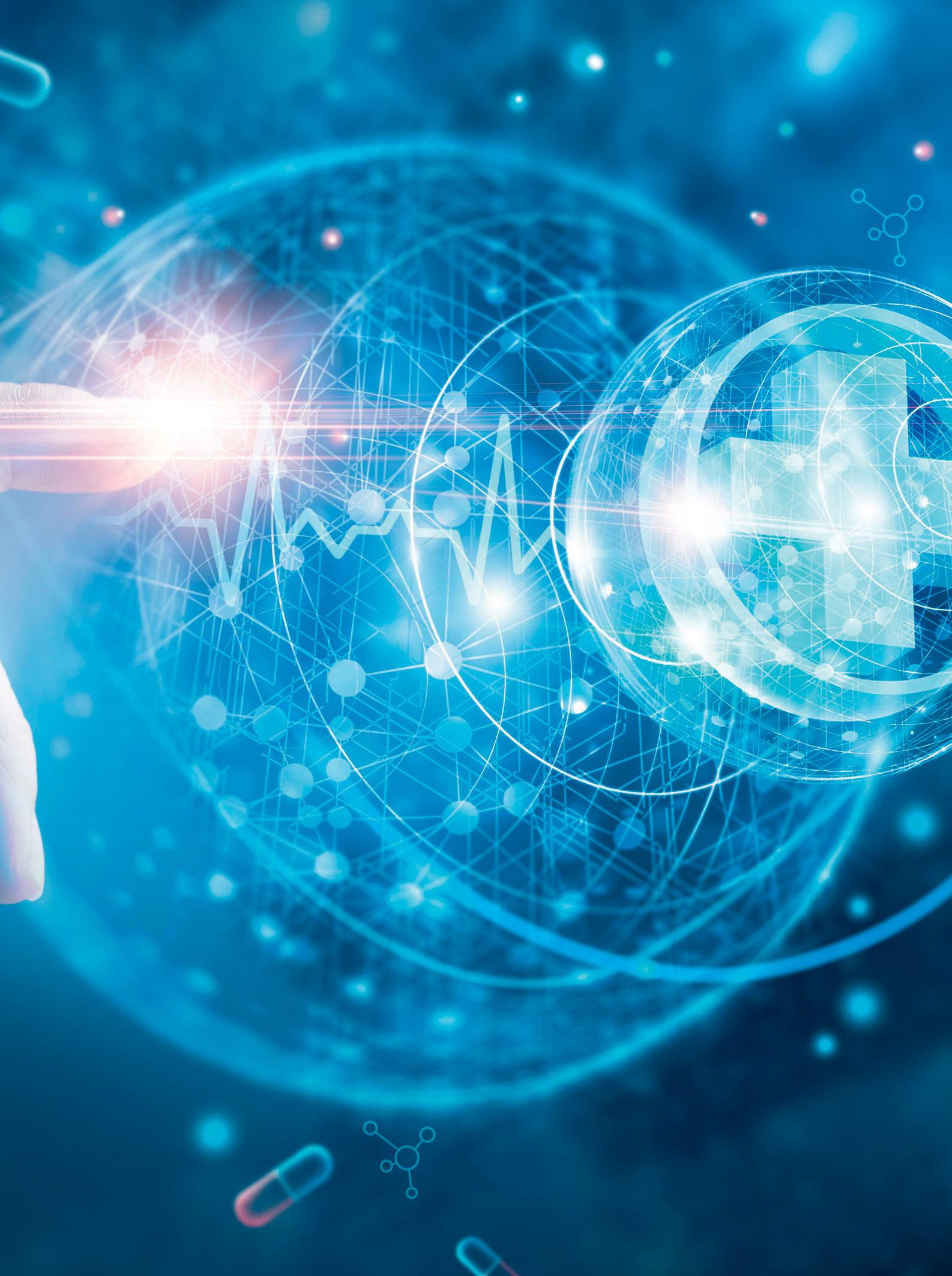
45% of workers in Australia’s healthcare and social assistance sector have university qualifications. Whatever your passion or goals, there’s a pathway to suit you.
*Source: labourmarketinsights.gov.au
rehabilitation, just to name a few. And the career paths are equally diverse and broad – after all, ‘healthcare and social assistance’ is the largest employing industry in Australia (see ‘Industry stats’). With a science + medicine career, you could be working in a hospital or a med-tech startup, for the government or in a private organisation.
Study pathways
If you’re interested in a career in the health sector, you should stick with your science electives in high school, particularly biology and chemistry. Advanced maths is also good – from public health statistics to dosage calculations, there are plenty of numbers in health and medicine.
Then, after school, there are so many different study pathways to choose from!
You could study a Bachelor of Science and specialise in any number of health-related majors, like medical science, biomedical
SHUTTERSTOCK
SCIENCE + MEDICINE Looking for more career inspo? Check out our A to Z of health jobs, including videos, career mentors and more. Visit: bit.ly/a-z-health-jobs CAREERS with STEM .com 20
Take 10
There are so many science + medicine careers to choose from. We’ve hidden just 10 in the below word search. How many can you find? (Find the answers at the bottom of the page)
SCIENCE + MEDICINE + STUDY
UNDERGRAD
Bachelor of Health
Science, Edith
Cowan University
Bachelor of Medical Sciences, Macquarie University
Bachelor of Biomedical Science, QUT
Bachelor of Food and Nutrition Science, University of Adelaide
Bachelor of Science (Medical Science), University of Sydney
VET COURSES
Certificate in Allied Health Assistance
Certificate in Community Health and Wellbeing
Certificate in Population Health
Diploma of Health Administration
science, nutrition or genetics. Or you could choose a more health-specific undergrad, like a Bachelor of Health Science, a Bachelor of Biomedical Science or a Bachelor of Laboratory Medicine.
These health and medical science degrees can lead to rewarding careers on their own, or they can be a pathway to becoming a doctor.
There are also plenty of vocational study pathways into the health sector. These can get you qualified to enter the workforce sooner – as a lab technician, for example – or they could lead to further education, especially if you didn’t get the ATAR you needed to go straight to uni after school. The upshot? If you love science and want to save lives one day, there’s likely a pathway out there for you in this crucial and in-demand sector. –
Gemma Chilton
SCIENCE + MEDICINE + JOBS
Biomedical scientist $78K–$137K

Epidemiologist $80K–$141K
Occupational therapist $81K–$141K
Sports dietitian $62K–$110K*
*Salary info according to payscale.com and salaryexpert.com
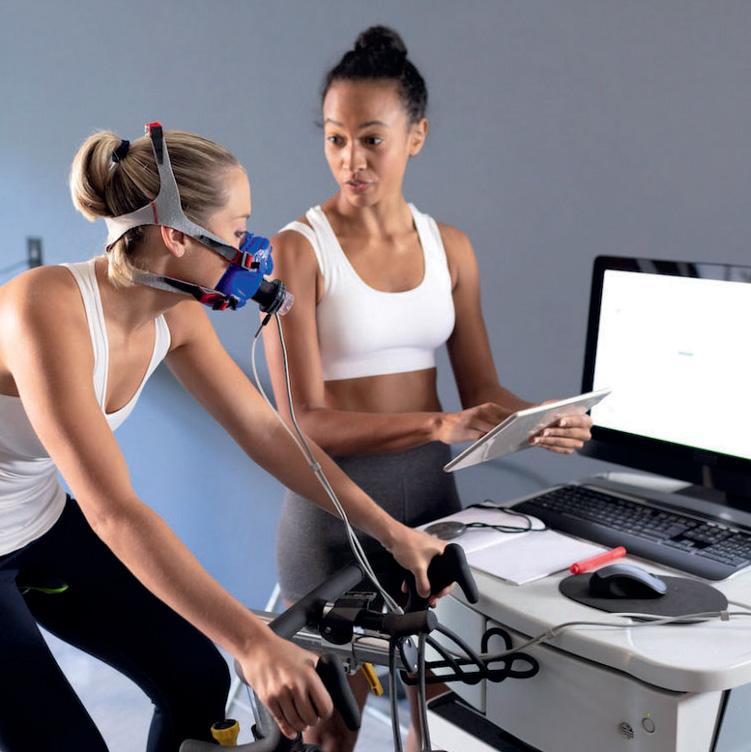
WORD SEARCH PUZZLE ANSWERS: BIOMEDICAL SCIENTIST, DIETICIAN, EPIDEMIOLOGIST, GENETICIST, IMMUNOLOGIST, NUTRITIONIST, PHARMACOLOGIST, PHYSIOTHERAPIST, SPEECH PATHOLOGIST, SPORTS SCIENTIST
health and medical science degrees can lead to rewarding careers on their own”
START YOUR CAREER HERE Find your perfect health science career Take our online personality quiz to find out what your dream job matching science and medicine could look like. Visit: CareerswithSTEM.com/health-quiz A P H Y S I O T H E R A P I S T W E S F S Y O G H B I O P A T H V U N M C A R E E R P O N B I O M E D I C A L S C I E N T I S T E U U B N Y U O I T S G I S T N U U R S C I E S T M O U W A S T I S T E P H A T P H A R C T R D I E T A G H T I S T B I O R M O I G H E S H O U S G T H E U I M N S U I F R I E P M P S P G P H A R D S P E E I M T M S P H A H O G E F O R T S D I E B I O O I E H E I T E R I C D N E T E N M E M C H P O U N O L H P T I A D N S C I T M M T E D I N P H Y S O I S A P E B S F F U U A C I A A I U I L L L D S J H R C I P E I N O L O C A S T H O L O E C I Y F A Y O E N O C A L O I T E B I O G M I H B G R S L E N L T I S T H A S E E H I I E B I H E I S T E O S C O U P O N U P L S O N G O J E P H Y E G G E N U G I S T H L T L T F S G G E N E T I C I S T I E O P A I O O I C U E T E J I N S N T I S A M B H R C D G S E N N S P E O O T B I O M U L E C M P B I T D S O H E L L O S P O T O N T G I S T A S E D O C G H E E P H A R M A C O L O G I S T
21 SCIENCE
Helping families using genetic research
The path to Aasta’s dream career wasn’t direct.
“I couldn’t work out what I wanted to be,” she says. “I left high school and started working, but I knew I wanted to do university – I love learning!”
Aasta started studying occupational therapy but decided it wasn’t for her and wound up working for a human genetics research institute in the UK instead. It was this experience that sparked her initial interest in genetics, but it wasn’t until later, when her second child was born with a rare syndrome, that Aasta’s interest in biological sciences was rekindled.
“It was my son’s geneticist who first put me onto genetic counselling. I knew it was what I wanted to do – I found my dream career at 35!”
She enrolled in a Bachelor of Science
aasta kelly research genetic counsellor
(Biomedical Science), with a focus on human genetics, at Edith Cowan University in Western Australia. A medical genetics placement, intensive research project and work experience placement during her degree confirmed her chosen path.
“My degree really opened doors for the cool jobs I have now,” Aasta says. “I met people who could see my passions and help guide them, and I was able to tailor the units to suit my interests and goals.”
Talking genes
Now, Aasta has two genetic counselling jobs, both of which she loves.
As a research genetic counsellor and project officer at the Harry Perkins Institute of Medical Research in Perth, she talks to families about
suspected genetic conditions, takes medical histories, explains DNA and genetics to them and discusses testing options.
Her other role is as a clinical genetic counsellor for Virtus Diagnostics, an Australian IVF and genetics company. In this job, she talks to people considering using donor eggs or sperm, and couples wanting to know whether they are at risk of passing on a serious genetic condition.
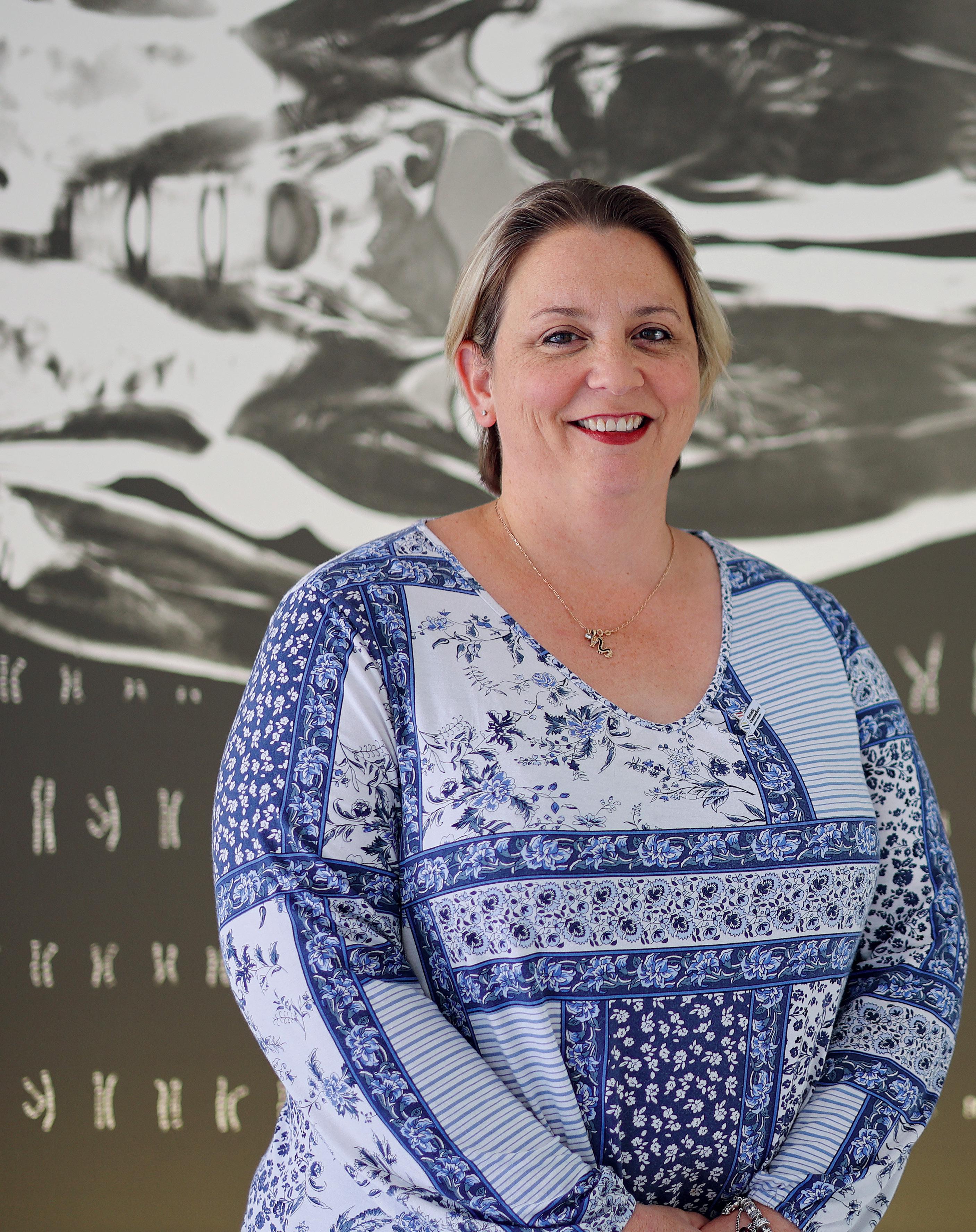
“I feel like I was always meant to be where I am now,” Aasta says of her career.

“By understanding rare disease and the impact of it on families, we aim to improve the health and wellbeing of generations to come.” –
Danielle Lucas
SCIENCE + MEDICINE: EDITH COWAN UNIVERSITY
Helpdesk coordinator, Henry Wellcome Building for Genomic Research, UK
Work experience student, Genetic Services of WA (GSWA)
Bachelor of Science (biomedical science), Edith Cowan University
Passion
and personal circumstances led Aasta Kelly to not one but two dream jobs in genetic counselling
Master of Genetic Counselling, UTS
Research genetic counsellor, Harry Perkins Institute of Medical Research
Clinical genetic counsellor, Virtus Diagnostics
CAREERS with STEM .com 22
My
degree
really opened doors for the cool jobs I have now”
So much more to STEM!
FOR STUDENTS
• Explore the jobs of the future with our FREE job kits

• Find your dream STEM study and career path with our online quizzes
• Search career role models and stories by X (your passion or interest) or by STEM
• Subscribe to our YouTube channel for career videos and webinars

• Connect, share and reach out on Insta or TikTok!
FOR TEACHERS
• Sign up to receive education resources and insights to your inbox every month
• Purchase (or download free) STEM careers posters for your classroom
• Register your class for a live STEM careers webinar
• Find extracurricular activities and competitions for STEM students

FOR PARENTS
• Sign up to our Parents Portal enews for tips and resources every month
• Subscribe to The Buzz About STEM podcast for parents of teens
• Download FREE Job Kits to help your teen explore the careers of the future
• Purchase or download resources including career posters and special edition magazines

for everyone: Like Careers with STEM? Join us, connect with other STEM-minded peeps and widen your network before you’ve even graduated! Join 1 STUDENTSMILLION each year who are growing their future with STEM!
with STEM is so much more than a magazine
We have STEM study and career resources
Careers
PATHS OF THE PAST
Are you a keen fossil or rock hound and passionate about the past? Discover how you can turn your interest into a rewarding career
There are many important (and surprising) ways to combine a love of historical artefacts with science to unlock the secrets of the past. But did you know looking ‘back in time’ can also help us tackle current issues like climate change and species extinction? Museums, governments, consultancies and universities are doing incredible work in this area – and they’re looking for passionate grads to help them. You could also find yourself working in a virtual reality lab, on a construction site or in the field helping to save threatened habitats. – Nadine
Undoing extinction
Can scientists bring the past to life... literally?

Scientists from the University of Melbourne are researching how to bring the Tasmanian tiger back from extinction.
To do this, they are sequencing DNA from Tasmanian tiger (or thylacine) specimens at Museums Victoria. These include a thylacine joey from 1909, which was used for the species’ first genome sequence in 2017. This research could help us reverse Australia’s high extinction rate. Since European colonisation, 100 Australian plant and animal species have died out.
“Using the DNA preserved in museum collections will help us understand how to preserve and recover the genetic diversity in living species, many of which are threatened with extinction,” says biologist Dr Kevin Rowe.
Kevin is the senior curator of mammals at Museums Victoria. He says scientists are preserving and editing DNA in living cells (such as skin cells) to match thylacine DNA. The next step is reprogramming the cells to become a living animal.
De-extinction ethics
Scientists working in this cutting-edge field need to consider resurrected animals’ habitat, diet and unexpected impacts on the environment.

But Kevin says the most important issue is what we are doing to reverse extinction – and more knowledge will help.
“We share this planet with nearly 10 million species but have named fewer than two million, and we know very little about most of those.” –
Nadine Cranenburgh
Cranenburgh
SHUTTERSTOCK NISH NIZAR
Using the dna in museum collections will help us preserve and recover living species”
SCIENCE + ANCIENT WORLDS
CAREERS with STEM .com 24
Dr kevin rowe senior curator
fun fields for fossil fiends
From studying ancient life to creating 3D models of lost habitats and creatures, there are many science disciplines with a stake in history!
1
Geology: Delving into rock samples can help us understand how natural forces have shaped the world and what that means for the future. Geology skills are in demand in many industries including mining, construction and space.
2Biology and genetics: Biologists and geneticists can study preserved plant and animal samples to help understand what we’ve lost, or even bring extinct species back from the dead. These skills are in demand across research, private industry, community organisations and government.
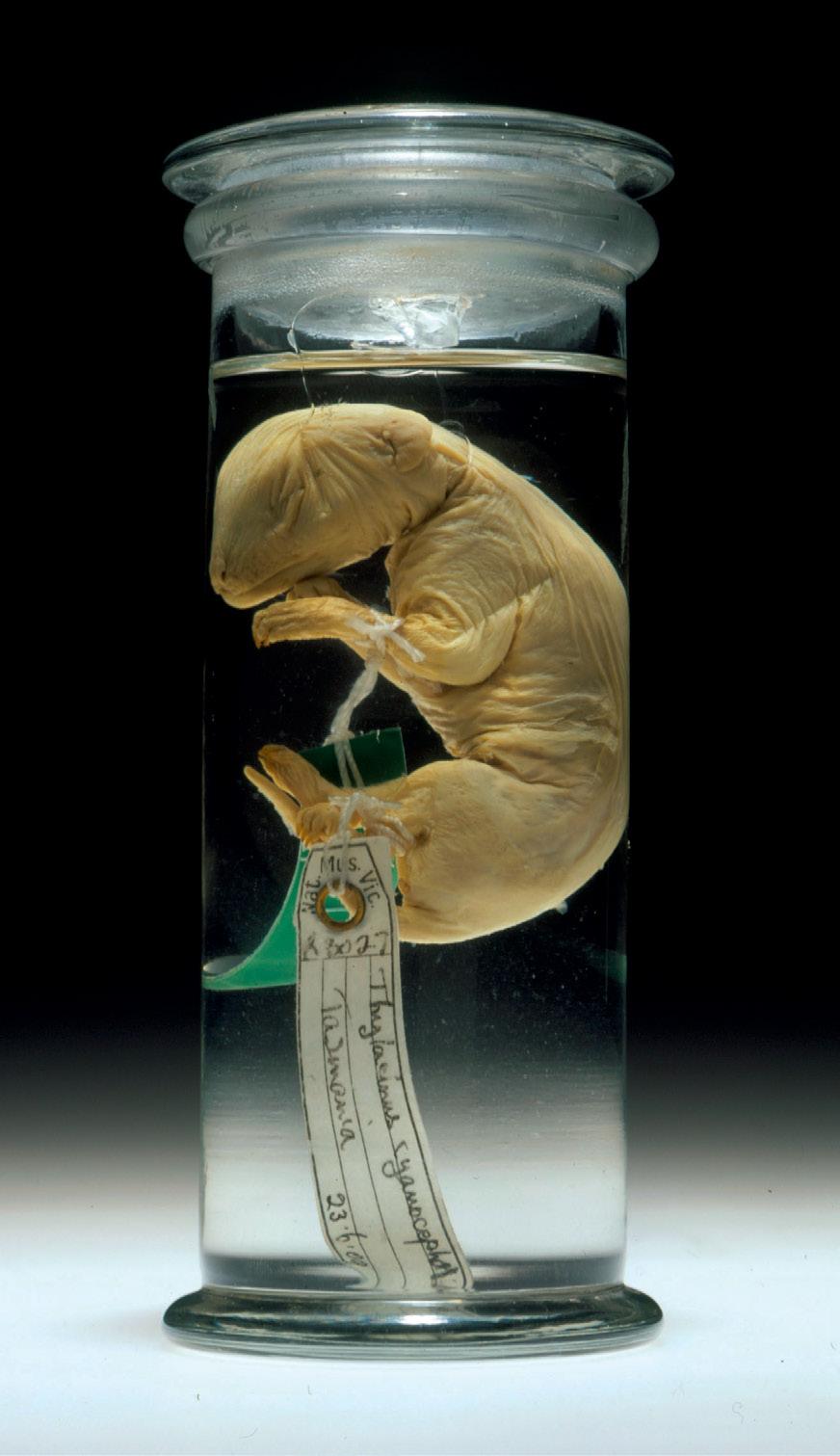
3
Palaeontology: One for the true fossil fanatics! Combining elements of geology and biology, palaeontologists study fossilised remains of ancient life and their natural habitats. Interesting palaeontology specialisations include plants and fungi, microscopic organisms and diseases, vanished ecosystems and past climate trends.
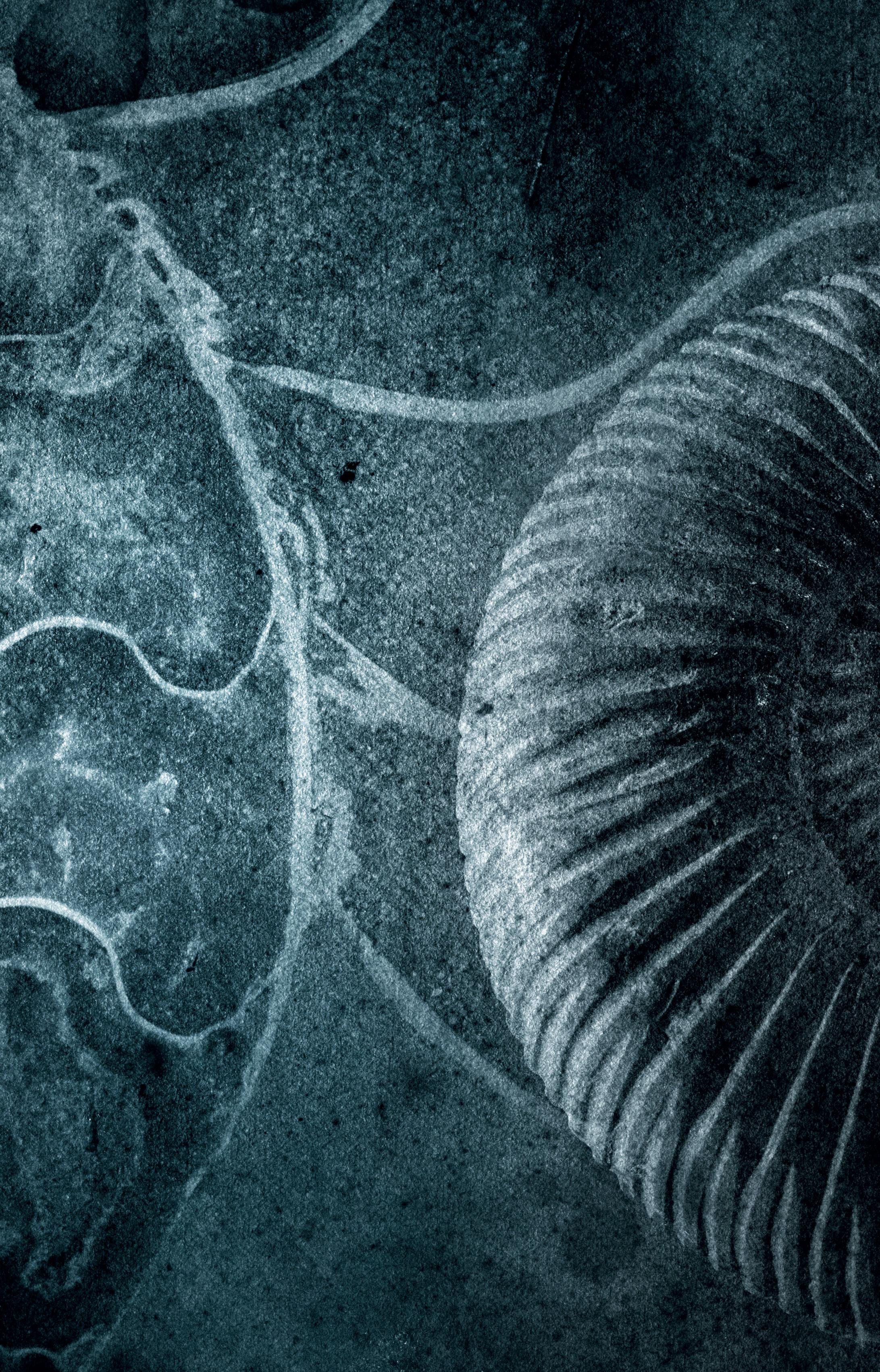
4Archaeology: Real-life archaeology may not be all about saving treasure from gun-toting villains, Indiana Jones style, but it’s still an exciting field. It involves the study of human artefacts such as prehistoric tools and art, as well as more recent artefacts including buildings and shipwrecks. There’s a lot of work for archaeologists outside of museum collections, such as recording and protecting Indigenous heritage and historical buildings.
5Computer and data science: These skills are in high demand and can help preserve the past and bring history to life. Using 3D modelling, scientists have recreated dinosaur habitats and ancient Grecian cities. Computer and data scientists can also delve into historical documents and data to show how civilisations have changed over time and help other scientists uncover trends to save species from extinction.
SCIENCE
+ ANCIENT WORLDS + STUDY
UNDERGRAD
Bachelor of Science (Palaeontology), Flinders University

Bachelor of Arts
/ Bachelor of Science, University of Adelaide
Bachelor of Ancient History, Macquarie University
POSTGRAD
Master of Arts (Archaeology), University of New England
Master of Climate Science, The University of Melbourne
Master of Environmental Science, Edith Cowan University
VET COURSES
Diploma of Environmental Monitoring and Technology
Diploma of Conservation and Ecosystem Management
SCIENCE + ANCIENT WORLDS + JOBS
Curator $49K–$92K
Archaeologist $54K–$143K
Geologist $72K–$136K Research scientist $58K–$109K*
*Sources: payscale.com and salaryexpert.com
TASMANIAN THYLACINE SPECIMEN IN MUSEUMS VICTORIA COLLECTION STORE MUSEUMS VICTORIA
START YOUR CAREER HERE
THYLACINE PUP. MUSEUMS VICTORIA
5
BENJAMIN HEALLEY
25 SCIENCE
DAVID PAUL
Raising the deep
Dr Maddy McAllister combines her love of the ocean with archaeology to bring shipwrecks to the surface and into the digital realm
As a child, Maddy roamed her local beach on the southwest coast of Western Australia. She considered becoming a marine biologist, but was also fascinated by history.
“I put them together to study maritime archaeology,” Maddy says. Maritime archaeologists investigate submerged human artefacts such as shipwrecks. This involves scuba-diving as well as office and lab work. Maddy is based near the Great Barrier Reef in Townsville as the senior curator of maritime archaeology at the Queensland Museum Network. Many ships met their ends on the treacherous reef and left intriguing artefacts behind. “We have about 8000 shipwreck artefacts. Everything from hull timbers, cannon balls, plates and bottles, to pieces of leather and ivory instruments,” Maddy says.
Follow your passion
Maddy’s career has taken her around Australia and overseas. After a Bachelor of Archaeology and Master of Maritime Archaeology at Flinders University in Adelaide, Maddy became an assistant curator at the
dr maddy maritimemcallisterarchaeologist
Western Australian Museum. One of her projects took her to Oman in Saudi Arabia to study underwater artefacts. Maddy’s museum work led into her PhD, during which she used digital photos of some of WA’s earliest shipwrecks to create 3D models.

After working as a maritime archaeologist for Heritage Victoria in Melbourne, Maddy took up her current role. She’s continuing to use technology to help everyone experience the thrill of an undisturbed shipwreck.
Maddy says arts and science are also good paths to archaeology. And she suggests getting creative with your career.
“Roles might not be exactly in your field, but they could be a combination of heritage management, museums or research that fits with your interests,” she says. –NadineCranenburgh
we have about 8000 shipwreck artefacts”
Bachelor of Archaeology, Flinders University
Master of Maritime Archaeology, Flinders University
SCIENCE + ANCIENT WORLDS QUEENSLAND MUSEUM NETWORK
Assistant Curator, Western Australian Museum Maritime Archaeologist, Department of Environment, Land, Water and Planning, Vic. Senior Curator, Queensland Museum Network PhD (archaeology), University of Western Australia
CAREERS with STEM .com 26
From Egypt to the stars
A combined passion for archaeology and space led Brenan Dew to a career that’s out of this world


From excavating ancient tombs to talking about space, Brenan Dew has had an impressively diverse career. “I didn’t really have a career plan,” he says. “I’ve always done what I find curious and along the way I’ve picked up transferable skills.”
As manager of the Australian Space Agency’s Australian Space Discovery Centre, he helps young people to see the variety of careers in this sector. “Yes, there’s astronaut and aerospace engineer, but there are careers in other areas too like space medicine and space law,” he says.
Skill crossover
Brenan wasn’t always so future focused. In fact, half his university studies involved looking to the past. A “tremendous amount of indecision” at the end of high school led him to study two very different degrees – ancient history and science – at Macquarie University.
“A real highlight from my studies was going to Egypt and helping run archaeological excavations,
often for two to three months at a time. I’d be learning about someone who lived in 1100 BC, then I’d come back to my studies in astrophysics and jump back into that other side of the brain,” he says. It was this multidisciplinary approach that landed him at the Australian Space Discovery Centre.
“Surprisingly, it was the unique combination of archaeology and astronomy that helped me get my current role,” Brenan says.
Pursuing a passion
Brenan now leads a team of 25 people at the hands-on, interactive centre where visitors learn about people working in space and the industries surrounding it.
Following a passion is his top advice. “It will often lead to a niche or specialisation in a field, putting you ahead of others,” he says. – Danielle Lucas
 brenan dew space centrediscovery manager
brenan dew space centrediscovery manager
SCIENCE + ANCIENT WORLDS: MACQUARIE UNIVERSITY
i’ve always done what I found curious”
Bachelor of Ancient History (Honours) / Bachelor of Science (astronomy and astrophysics), Macquarie University
Retail Assistant, Australian Geographic
Astronomy Educator, Sydney Observatory
Master of Research (egyptology), Macquarie University
Visitor Services, Sydney Observatory
Manager, Australian Space Discovery Centre
27 SCIENCE
5 ways to launch your science career … today
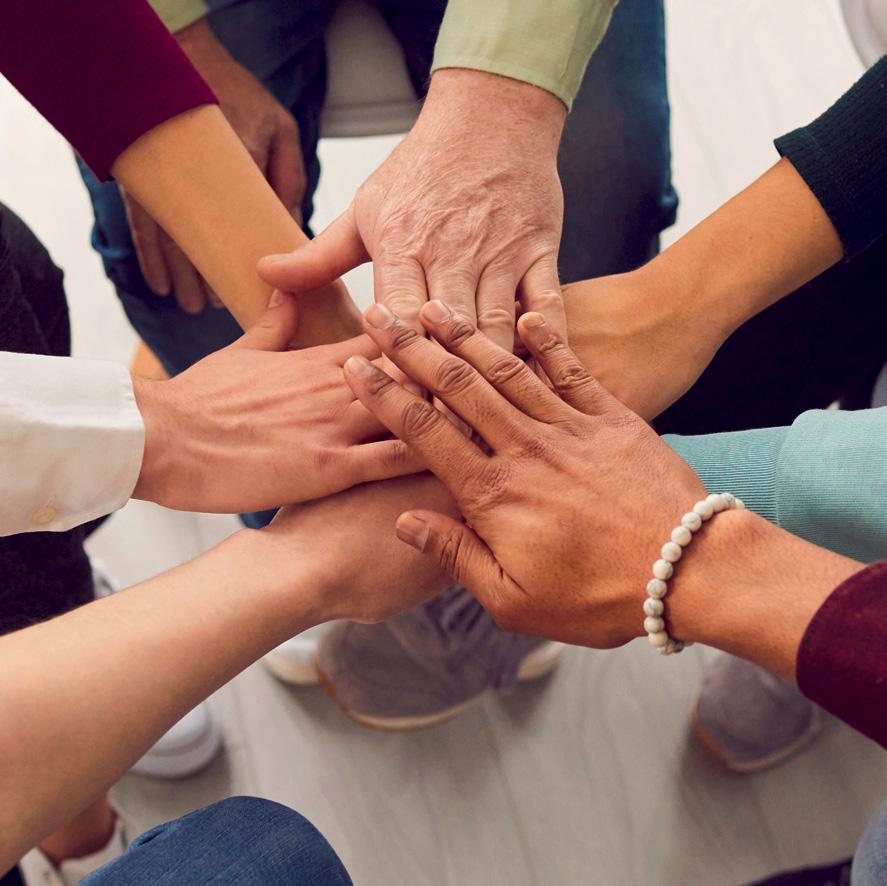
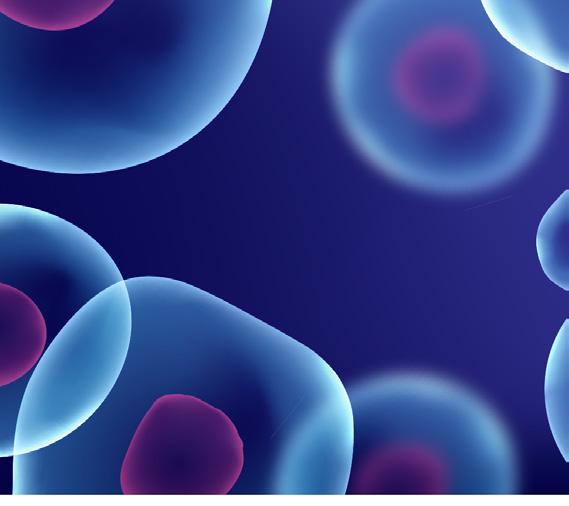



#1
Choose electives wisely
If you want a career in science, you’ll definitely want to stick with maths and have at least one senior science elective under your belt (flip back to page 8 to connect your science subjects with courses and careers!). Also make sure you consider any prerequisites to the uni course you have in mind. Hit up your school’s career counsellor or ask your science teacher if in doubt.


#2
Become a citizen scientist
This is a great way to start thinking like a scientist and legit contributing to the world of science before you’ve even finished high school! The Australian Citizen Science Association (citizenscience.org.au) has a list of current citizen science projects you can sign up for – don’t forget to add your efforts to your CV!
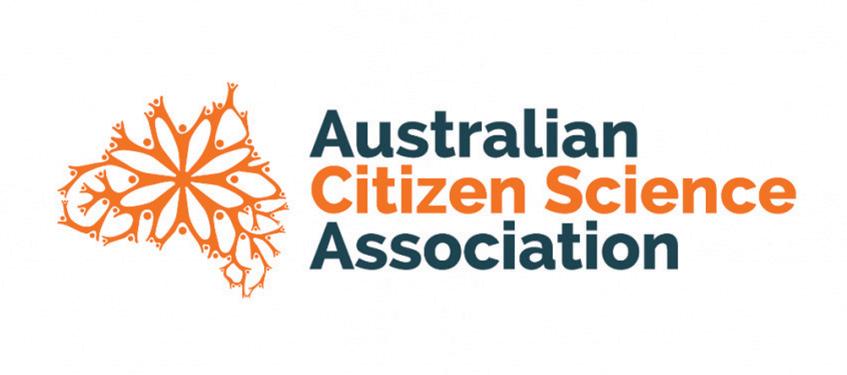
Sign up to our free webinar!
Want to meet real scientists and ask them all your burning career questions?
Careers with STEM has joined up with QUT to bring you free STEM + X webinar series to explore how you can combine a STEM degree with your ‘X’, which is your passion, another area or a big goal. Visit CareerswithSTEM.com/on-demand to register for our next webinar, or watch all our past ones in full, for free!

NEXT STEPS
SHUTTERSTOCK
CAREERS with STEM .com 28
#3
Enter into science competitions
Exam time shouldn’t be the only time to develop (or show off) your scientific prowess. Look into fairs and competitions. For example, you could take part in the Australian Science Olympiads, or the UNSW Bragg Student Prize for Science Writing – you might even win prizes!
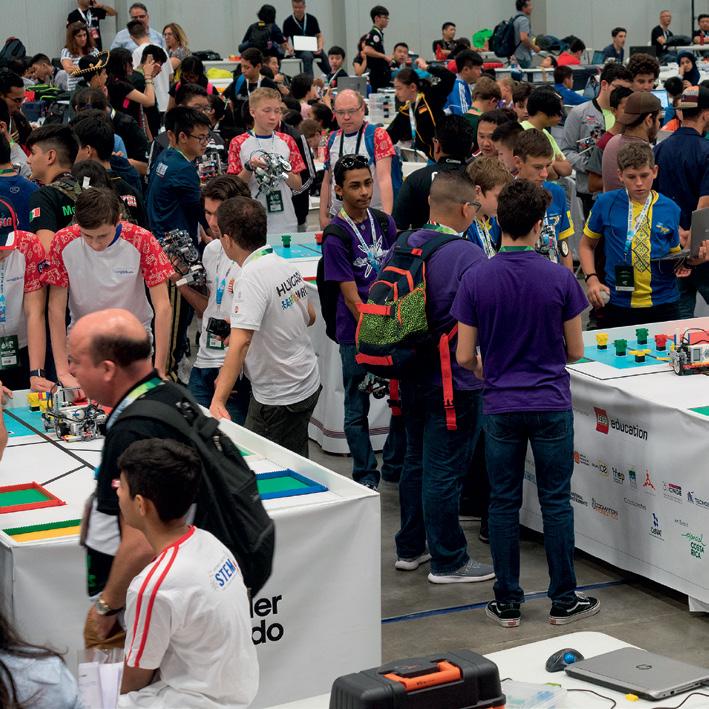
#4
Start exploring universities and colleges

You don’t have to wait until you’re in Year 12 or for uni open days to start thinking about your study path after school. Universities and vocational colleges like TAFE have loads of information online and are usually keen to talk you through their courses – there are so many options out there and the landscape is changing all the time.
christian de cos physiotherapy student
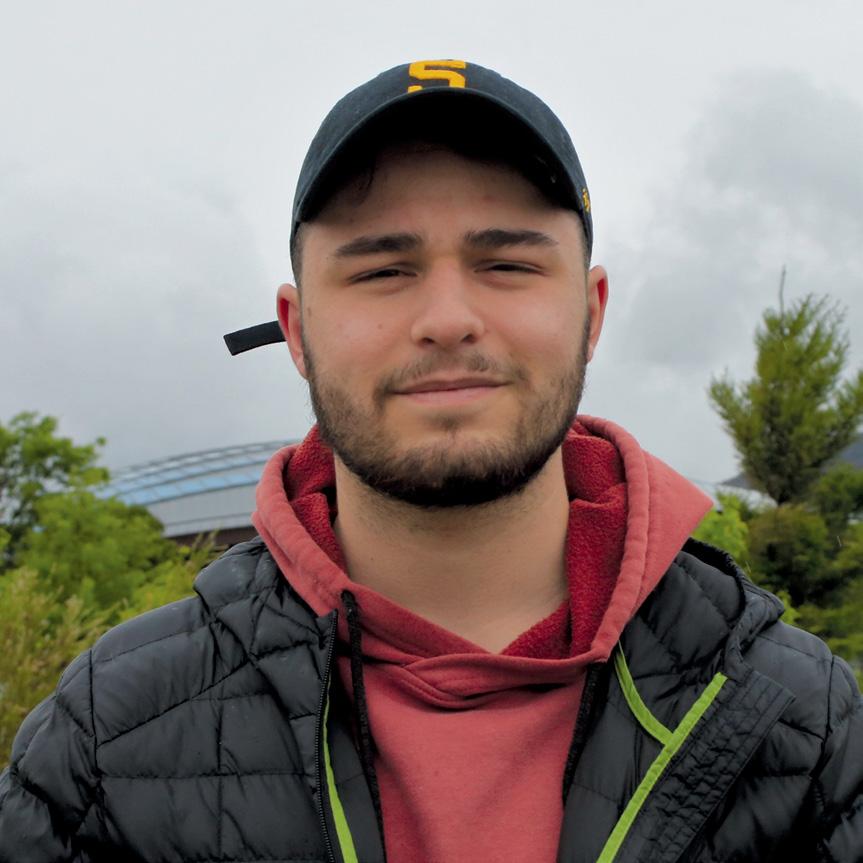
#5
Find mentors and role models
The best way to find out what a career in science is like is to ask a scientist! You’ll be surprised by how willing people are to help you if you’re genuinely interested and passionate. Start off on the Role Models section of CareerswithSTEM.com or just DM your favourite scientist on social media with your study and career Qs.
What’s that STEM job?
Did you know you can download our free, 8-page Careers with STEM job kits for a full low-down on specific STEM jobs? Get them at CareerswithSTEM.com/ jobkits
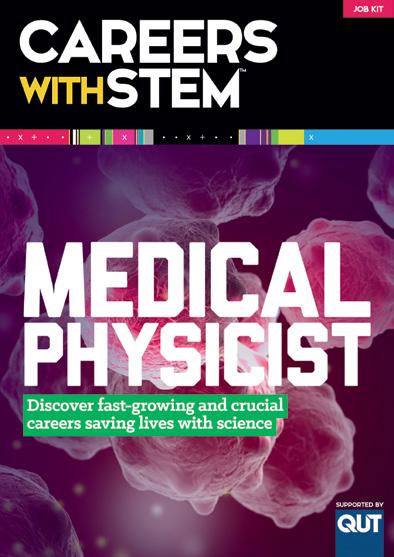
Careers with STEM: Science 2023 is a publication and trademark of Refraction Media. Copyright © 2023 Refraction Media, all rights reserved. No part of this publication may be reproduced in any manner or form without written permission. If you would like to reproduce anything from this magazine, email: info@refractionmedia.com.au.
We acknowledge the Traditional Owners of country throughout Australia and recognise their continuing connection to land, waters and culture. We pay our respects to their Elders past, present and emerging. This issue went to press on 15 January 2022. Printed in Australia by IVE.
Cover image: Lauren Trompp
Produced and published by: Refraction Media
Co-founder, CEO & Publisher: Karen Taylor-Brown
Co-founder, CEO & Head of Content: Heather Catchpole
Managing Editor: Gemma Chilton
Digital Editor: Cassie Steel
Digital Content Strategist: Louise Meers
Sub Editor: Amelia Caddy
Art Director: Katherine Power
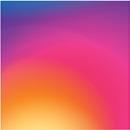
Writers: Cassie Steel, Chloe Walker, Danielle Lucas, Gemma Chilton, Heather Catchpole, Louise Meers, Nadine Cranenburgh
SUBSCRIBE AND ORDER COPIES: CareerswithSTEM.com /subscribe


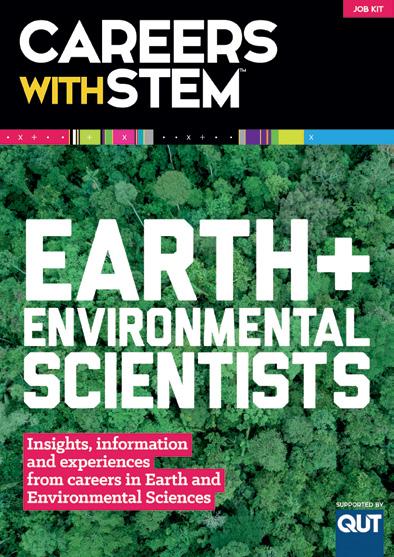
EDITORIAL & ADVERTISING ENQUIRIES: Email: info@refractionmedia.com.au or +612 9188 5459
POSTAL ADDRESS: PO Box 154, Oyster Bay, NSW 2225, Australia
CareerswithSTEM.com
ISSN 2209-1076

29 SCIENCE







































































 brenan dew space centrediscovery manager
brenan dew space centrediscovery manager





















